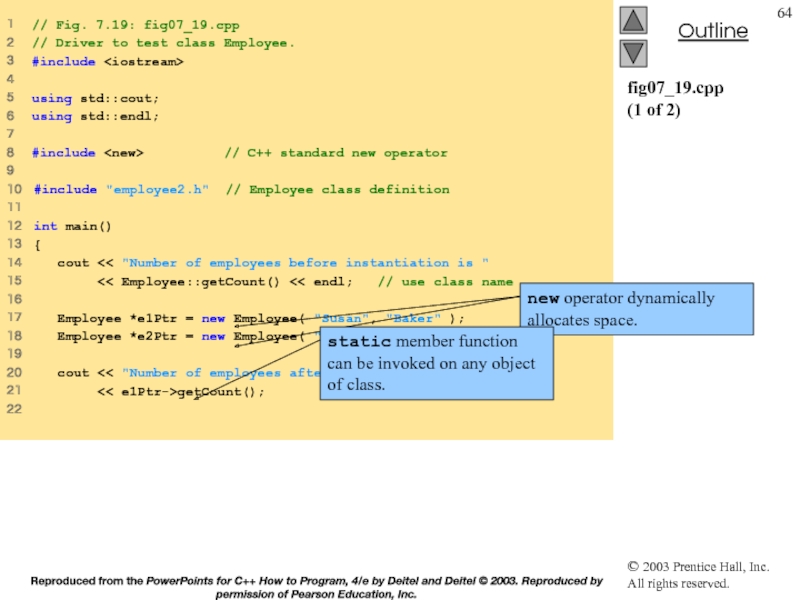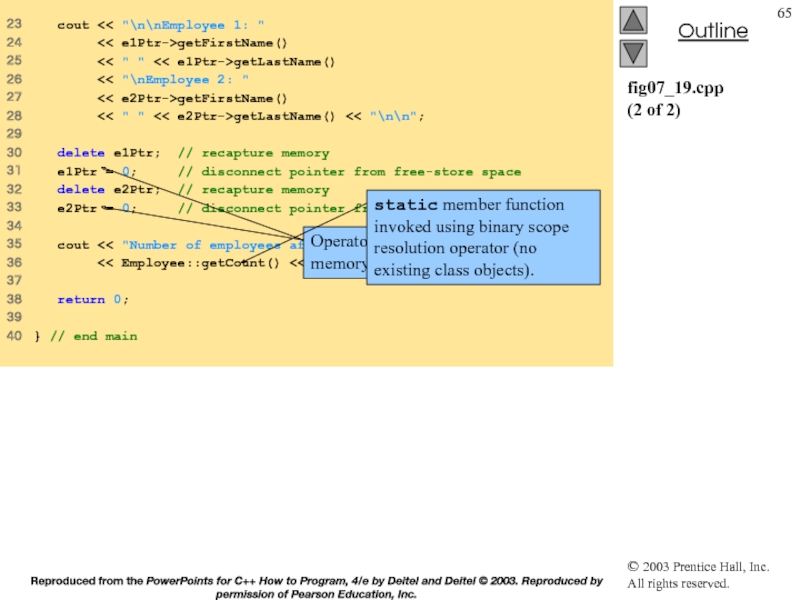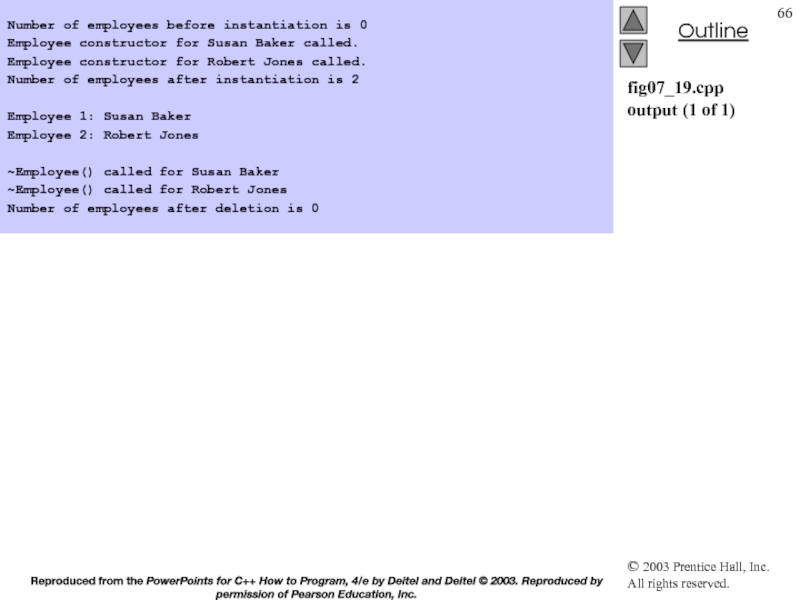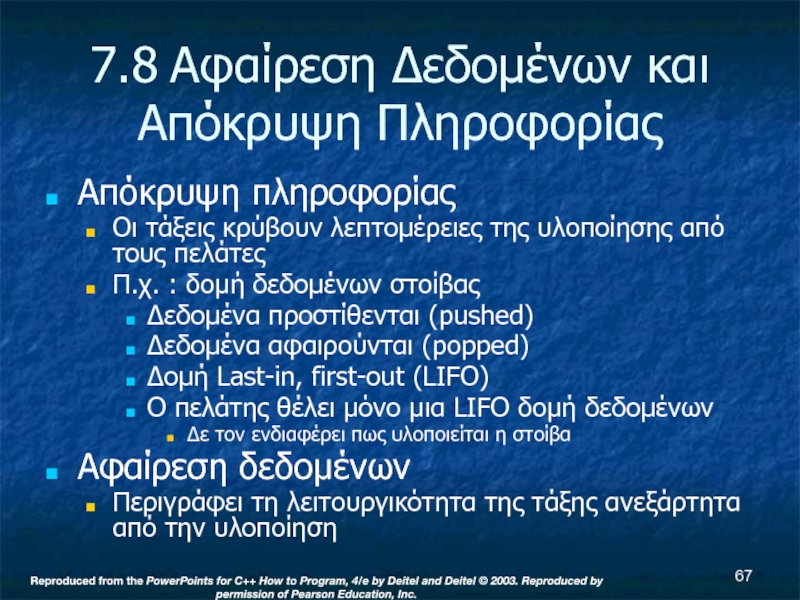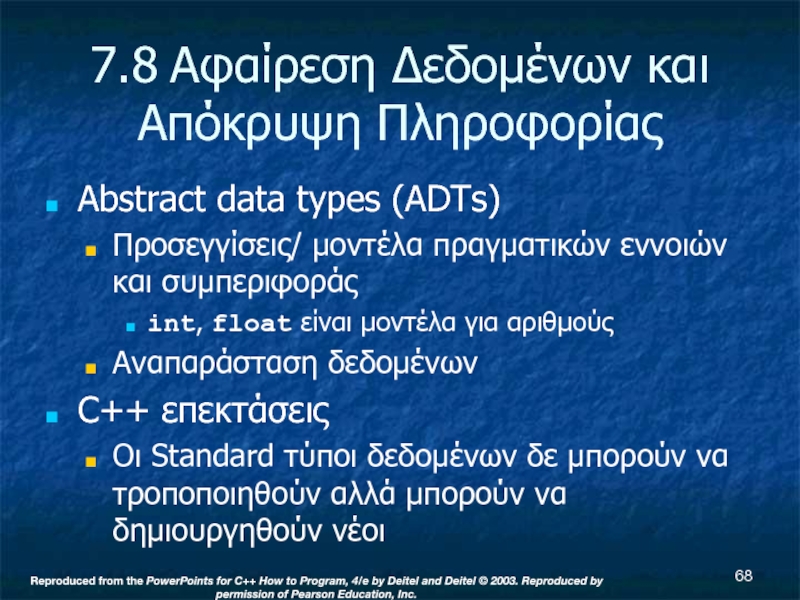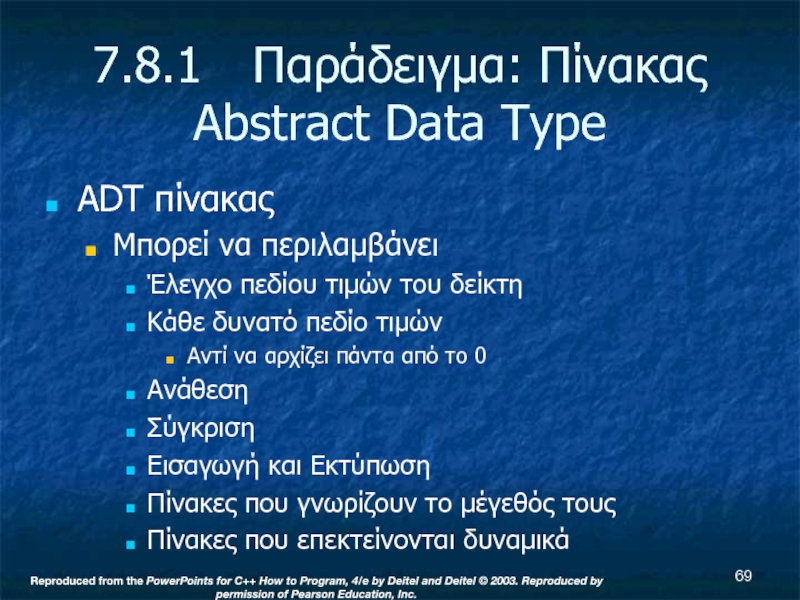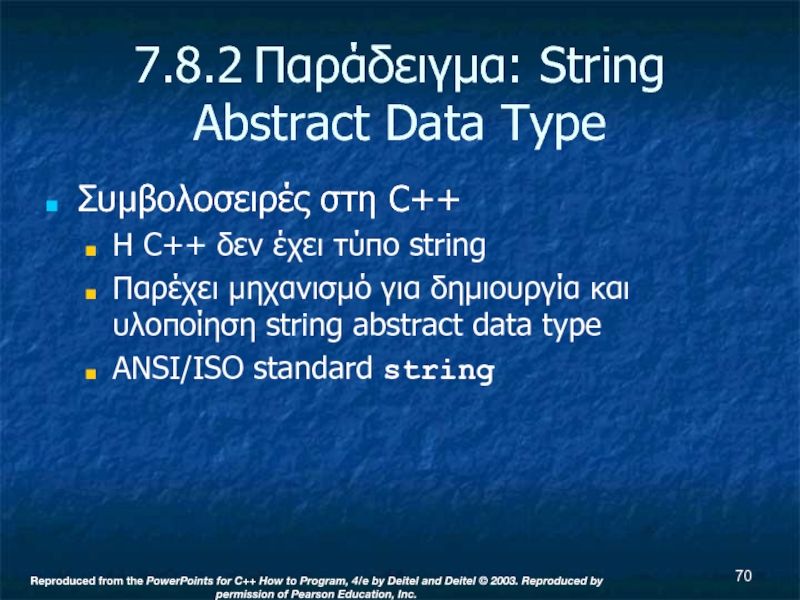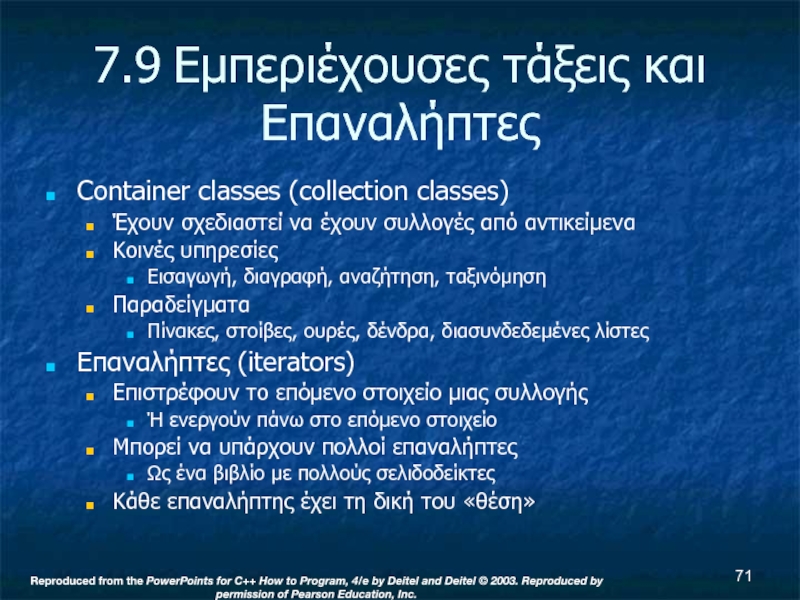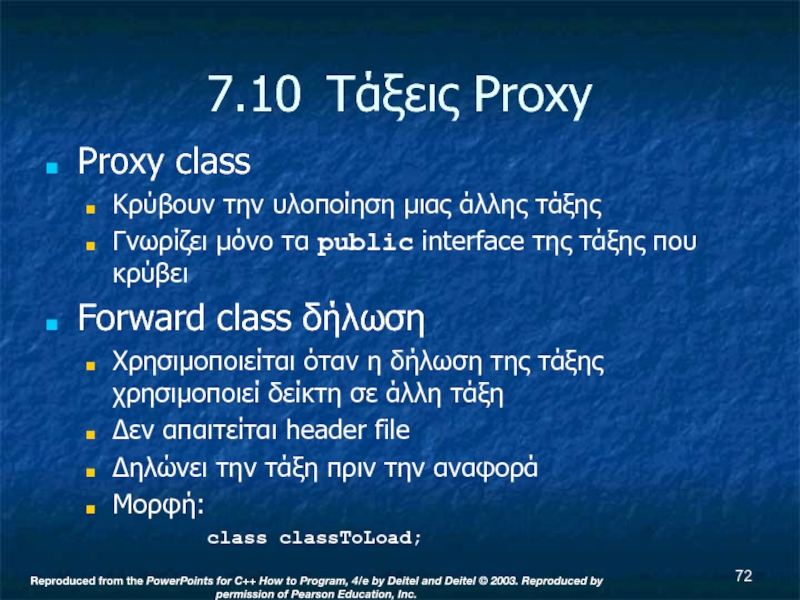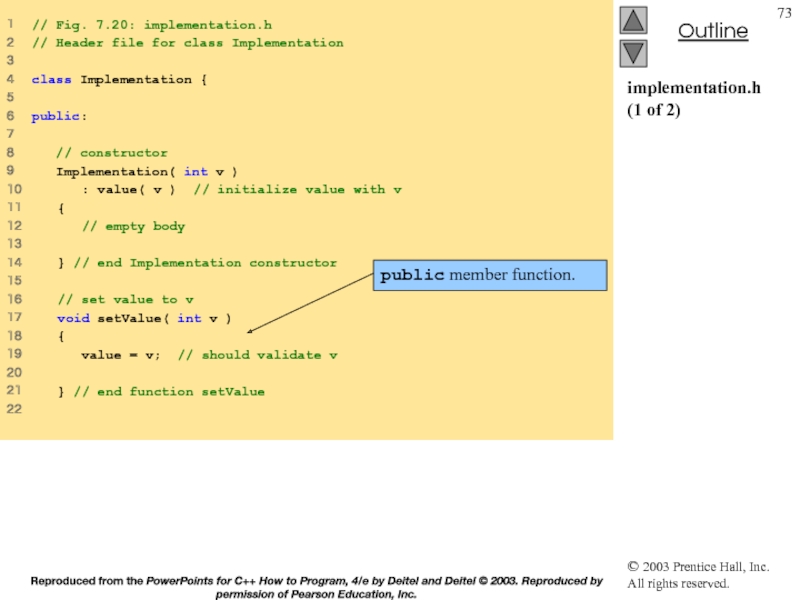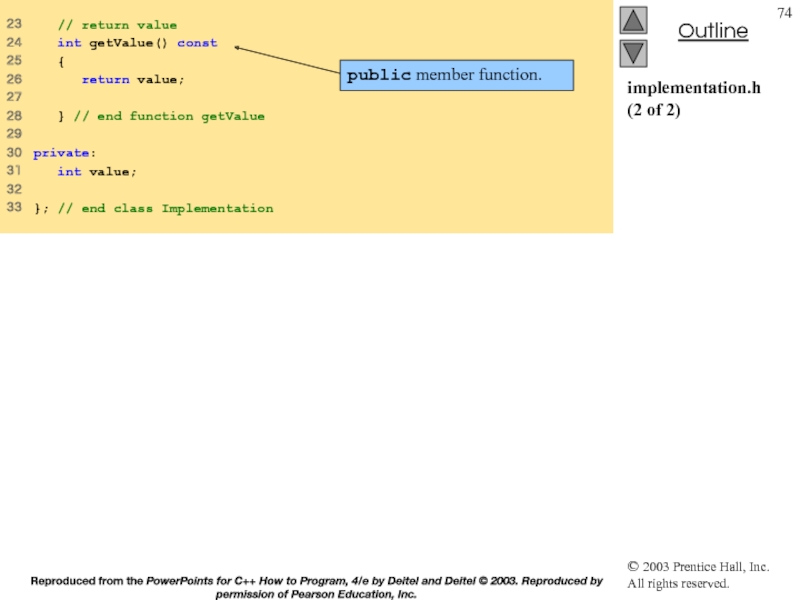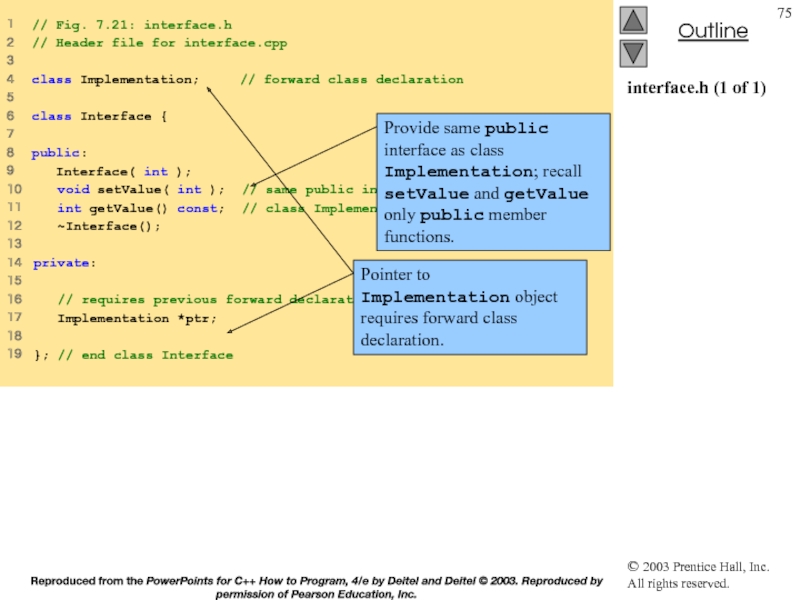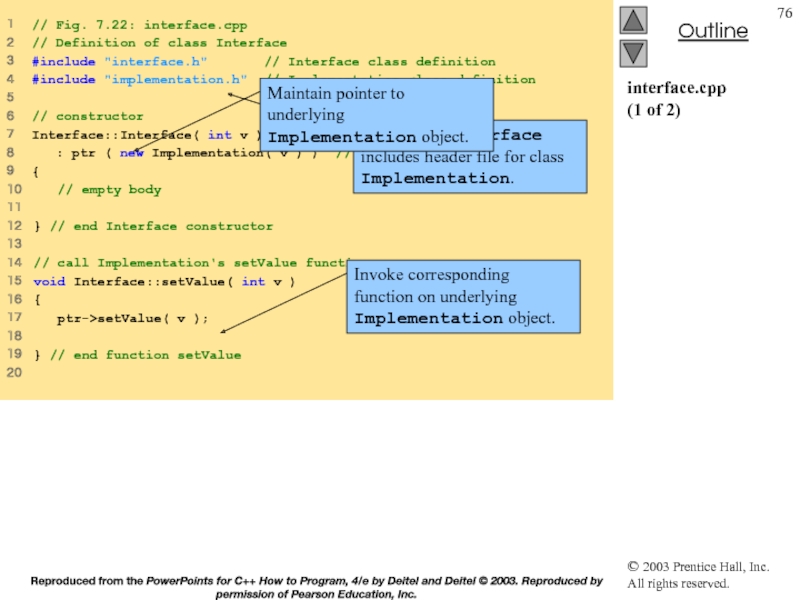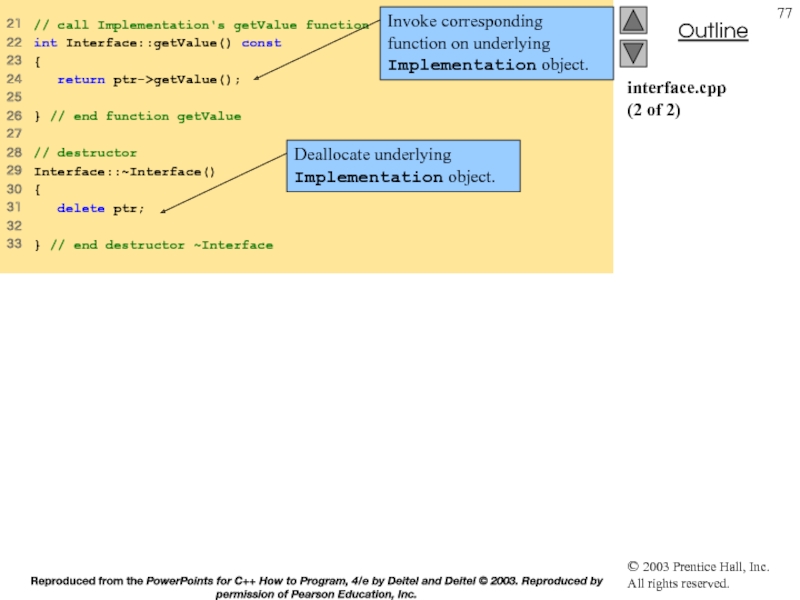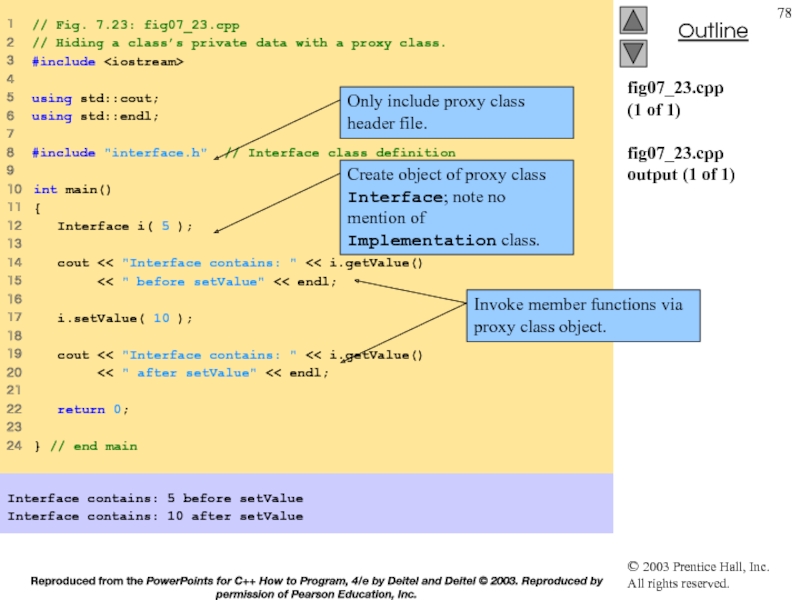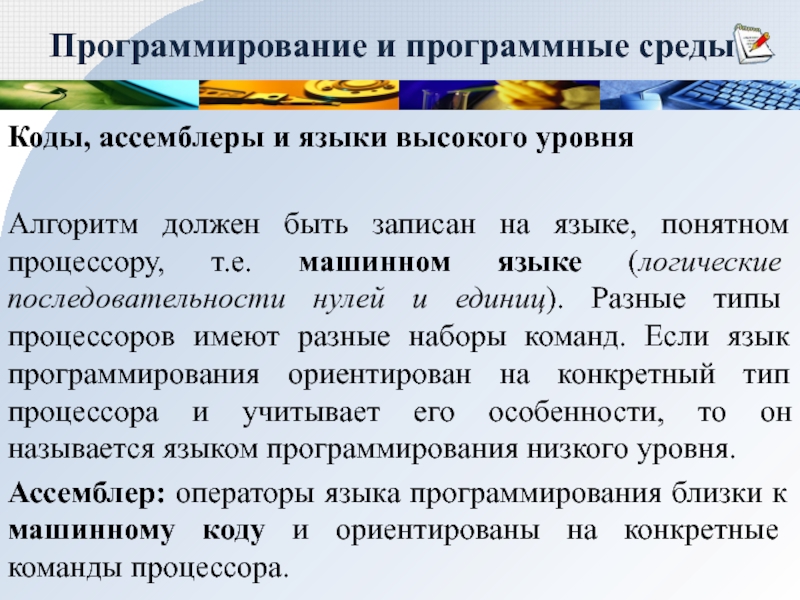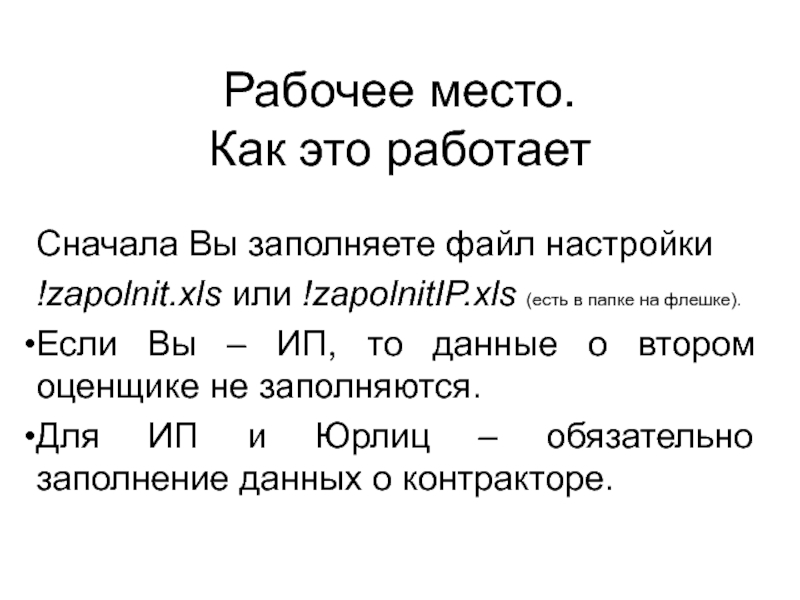- Главная
- Разное
- Дизайн
- Бизнес и предпринимательство
- Аналитика
- Образование
- Развлечения
- Красота и здоровье
- Финансы
- Государство
- Путешествия
- Спорт
- Недвижимость
- Армия
- Графика
- Культурология
- Еда и кулинария
- Лингвистика
- Английский язык
- Астрономия
- Алгебра
- Биология
- География
- Детские презентации
- Информатика
- История
- Литература
- Маркетинг
- Математика
- Медицина
- Менеджмент
- Музыка
- МХК
- Немецкий язык
- ОБЖ
- Обществознание
- Окружающий мир
- Педагогика
- Русский язык
- Технология
- Физика
- Философия
- Химия
- Шаблоны, картинки для презентаций
- Экология
- Экономика
- Юриспруденция
Οντοκεντρικοσ προγραμματισμοσ ΙΙ (С++). Τάξεις και αφαίρεση δεδομένων презентация
Содержание
- 1. Οντοκεντρικοσ προγραμματισμοσ ΙΙ (С++). Τάξεις και αφαίρεση δεδομένων
- 2. Τάξεις Μέρος ΙΙ 7.1 Εισαγωγή 7.2 const
- 3. Εισαγωγή Τάξεις Αφαίρεση Δεδομένων Αντικειμενοστραφής προγραμματισμός Κληρονομικότητα
- 4. 7.2 const (Σταθερά) Αντικείμενα και Μέθοδοι Η
- 5. 7.2 const (Σταθερά) Αντικείμενα και Μέθοδοι const
- 6. time5.h (1 of 2) 1
- 7. time5.h (2 of 2) 26
- 8. time5.cpp (1 of 4) 1
- 9. time5.cpp (2 of 4) 24
- 10. time5.cpp (3 of 4) 47
- 11. time5.cpp (4 of 4) 68
- 12. fig07_03.cpp (1 of 2) 1
- 13. fig07_03.cpp (2 of 2) fig07_03.cpp output
- 14. 7.2 const (Σταθερά) Αντικείμενα και Μέθοδοι Αρχικοποίηση
- 15. fig07_04.cpp (1 of 3) 1
- 16. fig07_04.cpp (2 of 3) 22
- 17. fig07_04.cpp (3 of 3) fig07_04.cpp output
- 18. fig07_05.cpp (1 of 3) 1
- 19. fig07_05.cpp (2 of 3) 22
- 20. fig07_05.cpp (3 of 3) fig07_05.cpp output
- 21. 7.3 Σύνθεση/ Composition: Αντικείμενα ως μέλη τάξης Σύνθεση/
- 22. date1.h (1 of 1) 1
- 23. date1.cpp (1 of 3) 1
- 24. date1.cpp (2 of 3) 26
- 25. date1.cpp (3 of 3) 49
- 26. employee1.h (1 of 2) 1
- 27. employee1.h (2 of 2) employee1.cpp (1
- 28. employee1.cpp (2 of 3) 13
- 29. employee1.cpp (3 of 3) 38
- 30. fig07_10.cpp (1 of 1) 1
- 31. fig07_10.cpp output (1 of 1)
- 32. 7.4 friend Συναρτήσεις και friend Τάξεις friend
- 33. 7.4 friend Συναρτήσεις και and friend Τάξεις
- 34. fig07_11.cpp (1 of 3) 1
- 35. fig07_11.cpp (2 of 3) 22
- 36. fig07_11.cpp (3 of 3) fig07_11.cpp
- 37. fig07_12.cpp (1 of 3)
- 38. fig07_12.cpp (2 of 3)
- 39. fig07_12.cpp (3 of 3) fig07_12.cpp
- 40. 7.5 Χρήση του this this Επιτρέπει στο αντικείμενο
- 41. fig07_13.cpp (1 of 3)
- 42. fig07_13.cpp (2 of 3)
- 43. fig07_13.cpp (3 of 3) fig07_13.cpp
- 44. 7.5 Χρήση του this Σειριακή κλήση συναρτήσεων Πολλαπλές
- 45. time6.h (1 of 2) 1
- 46. time6.h (2 of 2) 25
- 47. time6.cpp (1 of 5) 1
- 48. time6.cpp (2 of 5) 23
- 49. time6.cpp (3 of 5) 43
- 50. time6.cpp (4 of 5) 68
- 51. time6.cpp (5 of 5) 91
- 52. fig07_16.cpp (1 of 2) 1
- 53. fig07_16.cpp (2 of 2) fig07_16.cpp output
- 54. 7.6 Διαχείριση Δυναμικής Μνήμης με χρήση new
- 55. 7.6 Διαχείριση Δυναμικής Μνήμης με χρήση new
- 56. 7.6 Διαχείριση Δυναμικής Μνήμης με χρήση new
- 57. 7.7 static τάξεις static τάξης μεταβλητή Δεδομένα διαθέσιμα
- 58. 7.7 static τάξεις Πρόσβαση σε μεταβλητές τάξης static
- 59. 7.7 static τάξεις static συναρτήσεις Δε μπορούν να
- 60. employee2.h (1 of 2) 1
- 61. employee2.h (2 of 2) employee2.cpp (1
- 62. employee2.cpp (2 of 3) 23
- 63. employee2.cpp (3 of 3) 48
- 64. fig07_19.cpp (1 of 2) 1
- 65. fig07_19.cpp (2 of 2) 23 cout
- 66. fig07_19.cpp output (1 of 1)
- 67. 7.8 Αφαίρεση Δεδομένων και Απόκρυψη Πληροφορίας Απόκρυψη πληροφορίας
- 68. 7.8 Αφαίρεση Δεδομένων και Απόκρυψη Πληροφορίας Abstract data
- 69. 7.8.1 Παράδειγμα: Πίνακας Abstract Data Type ADT
- 70. 7.8.2 Παράδειγμα: String Abstract Data Type Συμβολοσειρές στη
- 71. 7.9 Εμπεριέχουσες τάξεις και Επαναλήπτες Container classes
- 72. 7.10 Τάξεις Proxy Proxy class Κρύβουν την υλοποίηση
- 73. implementation.h (1 of 2) 1
- 74. implementation.h (2 of 2) 23
- 75. interface.h (1 of 1) 1
- 76. interface.cpp (1 of 2) 1
- 77. interface.cpp (2 of 2) 21
- 78. fig07_23.cpp (1 of 1) fig07_23.cpp output
Слайд 1Τμήμα Μηχανικών Ηλεκτρονικών Υπολογιστών και Πληροφορικής
Πανεπιστήμιο Πατρών
ΟΝΤΟΚΕΝΤΡΙΚΟΣ ΠΡΟΓΡΑΜΜΑΤΙΣΜΟΣ ΙΙ (C++)
Τάξεις και
Слайд 2Τάξεις Μέρος ΙΙ
7.1 Εισαγωγή
7.2 const Αντικείμενα και const Συναρτήσεις
7.3 Σύνθεση: Αντικείμενα
Reproduced from the PowerPoints for C++ How to Program, 4/e by Deitel and Deitel © 2003. Reproduced by permission of Pearson Education, Inc.
Слайд 3Εισαγωγή
Τάξεις
Αφαίρεση Δεδομένων
Αντικειμενοστραφής προγραμματισμός
Κληρονομικότητα και πολυμορφισμός
Reproduced from the PowerPoints for C++ How
Слайд 47.2 const (Σταθερά) Αντικείμενα και Μέθοδοι
Η αρχή της ελάχιστης πρόσβασης
Επιτρέπουμε πρόσβαση
const
Ορίζει αντικείμενο που δε τροποποιείται
Δίνει Compiler error
Παράδειγμα
const Time noon( 12, 0, 0 );
Δηλώνει const αντικείμενο noon της Time
Αρχικοποιεί σε 12
Reproduced from the PowerPoints for C++ How to Program, 4/e by Deitel and Deitel © 2003. Reproduced by permission of Pearson Education, Inc.
Слайд 57.2 const (Σταθερά) Αντικείμενα και Μέθοδοι
const μέθοδοι
Οι μέθοδοι αντικειμένων const πρέπει
Δε μπορεί να τροποποιούν αντικείμενα
Ορίζουμε ως const σε
Πρωτότυπο
Μετά τη λίστα παραμέτρων
Δηλώσεις
Πριν την αρχή του αριστερού αγκίστρου
Reproduced from the PowerPoints for C++ How to Program, 4/e by Deitel and Deitel © 2003. Reproduced by permission of Pearson Education, Inc.
Слайд 6time5.h (1 of 2)
1 // Fig. 7.1: time5.h
2
3 // Member functions defined in time5.cpp.
4 #ifndef TIME5_H
5 #define TIME5_H
6
7 class Time {
8
9 public:
10 Time( int = 0, int = 0, int = 0 ); // default constructor
11
12 // set functions
13 void setTime( int, int, int ); // set time
14 void setHour( int ); // set hour
15 void setMinute( int ); // set minute
16 void setSecond( int ); // set second
17
18 // get functions (normally declared const)
19 int getHour() const; // return hour
20 int getMinute() const; // return minute
21 int getSecond() const; // return second
22
23 // print functions (normally declared const)
24 void printUniversal() const; // print universal time
25 void printStandard(); // print standard time
Reproduced from the PowerPoints for C++ How to Program, 4/e by Deitel and Deitel © 2003. Reproduced by permission of Pearson Education, Inc.
Слайд 7time5.h (2 of 2)
26
27 private:
28
29 int minute; // 0 - 59
30 int second; // 0 - 59
31
32 }; // end class Time
33
34 #endif
Reproduced from the PowerPoints for C++ How to Program, 4/e by Deitel and Deitel © 2003. Reproduced by permission of Pearson Education, Inc.
Слайд 8time5.cpp (1 of 4)
1 // Fig. 7.2: time5.cpp
2
3 #include
4
5 using std::cout;
6
7 #include
8
9 using std::setfill;
10 using std::setw;
11
12 // include definition of class Time from time5.h
13 #include "time5.h"
14
15 // constructor function to initialize private data;
16 // calls member function setTime to set variables;
17 // default values are 0 (see class definition)
18 Time::Time( int hour, int minute, int second )
19 {
20 setTime( hour, minute, second );
21
22 } // end Time constructor
23
Reproduced from the PowerPoints for C++ How to Program, 4/e by Deitel and Deitel © 2003. Reproduced by permission of Pearson Education, Inc.
Слайд 9time5.cpp (2 of 4)
24 // set hour, minute and second
25 void Time::setTime( int hour, int minute, int second )
26 {
27 setHour( hour );
28 setMinute( minute );
29 setSecond( second );
30
31 } // end function setTime
32
33 // set hour value
34 void Time::setHour( int h )
35 {
36 hour = ( h >= 0 && h < 24 ) ? h : 0;
37
38 } // end function setHour
39
40 // set minute value
41 void Time::setMinute( int m )
42 {
43 minute = ( m >= 0 && m < 60 ) ? m : 0;
44
45 } // end function setMinute
46
Reproduced from the PowerPoints for C++ How to Program, 4/e by Deitel and Deitel © 2003. Reproduced by permission of Pearson Education, Inc.
Слайд 10time5.cpp (3 of 4)
47 // set second value
48 void
49 {
50 second = ( s >= 0 && s < 60 ) ? s : 0;
51
52 } // end function setSecond
53
54 // return hour value
55 int Time::getHour() const
56 {
57 return hour;
58
59 } // end function getHour
60
61 // return minute value
62 int Time::getMinute() const
63 {
64 return minute;
65
66 } // end function getMinute
67
Reproduced from the PowerPoints for C++ How to Program, 4/e by Deitel and Deitel © 2003. Reproduced by permission of Pearson Education, Inc.
Слайд 11time5.cpp (4 of 4)
68 // return second value
69 int
70 {
71 return second;
72
73 } // end function getSecond
74
75 // print Time in universal format
76 void Time::printUniversal() const
77 {
78 cout << setfill( '0' ) << setw( 2 ) << hour << ":"
79 << setw( 2 ) << minute << ":"
80 << setw( 2 ) << second;
81
82 } // end function printUniversal
83
84 // print Time in standard format
85 void Time::printStandard() // note lack of const declaration
86 {
87 cout << ( ( hour == 0 || hour == 12 ) ? 12 : hour % 12 )
88 << ":" << setfill( '0' ) << setw( 2 ) << minute
89 << ":" << setw( 2 ) << second
90 << ( hour < 12 ? " AM" : " PM" );
91
92 } // end function printStandard
Reproduced from the PowerPoints for C++ How to Program, 4/e by Deitel and Deitel © 2003. Reproduced by permission of Pearson Education, Inc.
Слайд 12fig07_03.cpp
(1 of 2)
1 // Fig. 7.3: fig07_03.cpp
2
3 // non-const member functions.
4
5 // include Time class definition from time5.h
6 #include "time5.h"
7
8 int main()
9 {
10 Time wakeUp( 6, 45, 0 ); // non-constant object
11 const Time noon( 12, 0, 0 ); // constant object
12
Reproduced from the PowerPoints for C++ How to Program, 4/e by Deitel and Deitel © 2003. Reproduced by permission of Pearson Education, Inc.
Слайд 13fig07_03.cpp
(2 of 2)
fig07_03.cpp
output (1 of 1)
13
14 wakeUp.setHour( 18 ); // non-const non-const
15
16 noon.setHour( 12 ); // const non-const
17
18 wakeUp.getHour(); // non-const const
19
20 noon.getMinute(); // const const
21 noon.printUniversal(); // const const
22
23 noon.printStandard(); // const non-const
24
25 return 0;
26
27 } // end main
d:\cpphtp4_examples\ch07\fig07_01\fig07_01.cpp(16) : error C2662:
'setHour' : cannot convert 'this' pointer from 'const class Time'
to 'class Time &'
Conversion loses qualifiers
d:\cpphtp4_examples\ch07\fig07_01\fig07_01.cpp(23) : error C2662:
'printStandard' : cannot convert 'this' pointer from 'const class
Time' to 'class Time &'
Conversion loses qualifiers
Reproduced from the PowerPoints for C++ How to Program, 4/e by Deitel and Deitel © 2003. Reproduced by permission of Pearson Education, Inc.
Слайд 147.2 const (Σταθερά) Αντικείμενα και Μέθοδοι
Αρχικοποίηση αντικειμένου
Αρχικοποίηση με member initializer syntax
Μπορεί
Με όλα τα μέλη δεδομένων
Πρέπει να χρησιμοποιηθεί
Για τα μέλη const
Για όλες τις αναφορές μεταβλητών
Reproduced from the PowerPoints for C++ How to Program, 4/e by Deitel and Deitel © 2003. Reproduced by permission of Pearson Education, Inc.
Слайд 15fig07_04.cpp
(1 of 3)
1 // Fig. 7.4: fig07_04.cpp
2
3 // constant of a built-in data type.
4 #include
5
6 using std::cout;
7 using std::endl;
8
9 class Increment {
10
11 public:
12 Increment( int c = 0, int i = 1 ); // default constructor
13
14 void addIncrement()
15 {
16 count += increment;
17
18 } // end function addIncrement
19
20 void print() const; // prints count and increment
21
Reproduced from the PowerPoints for C++ How to Program, 4/e by Deitel and Deitel © 2003. Reproduced by permission of Pearson Education, Inc.
Слайд 16fig07_04.cpp
(2 of 3)
22 private:
23 int count;
24
25
26 }; // end class Increment
27
28 // constructor
29 Increment::Increment( int c, int i )
30 : count( c ), // initializer for non-const member
31 increment( i ) // required initializer for const member
32 {
33 // empty body
34
35 } // end Increment constructor
36
37 // print count and increment values
38 void Increment::print() const
39 {
40 cout << "count = " << count
41 << ", increment = " << increment << endl;
42
43 } // end function print
44
Reproduced from the PowerPoints for C++ How to Program, 4/e by Deitel and Deitel © 2003. Reproduced by permission of Pearson Education, Inc.
Слайд 17fig07_04.cpp
(3 of 3)
fig07_04.cpp
output (1 of 1)
45 int main()
46 {
47
48
49 cout << "Before incrementing: ";
50 value.print();
51
52 for ( int j = 0; j < 3; j++ ) {
53 value.addIncrement();
54 cout << "After increment " << j + 1 << ": ";
55 value.print();
56 }
57
58 return 0;
59
60 } // end main
Before incrementing: count = 10, increment = 5
After increment 1: count = 15, increment = 5
After increment 2: count = 20, increment = 5
After increment 3: count = 25, increment = 5
Reproduced from the PowerPoints for C++ How to Program, 4/e by Deitel and Deitel © 2003. Reproduced by permission of Pearson Education, Inc.
Слайд 18fig07_05.cpp
(1 of 3)
1 // Fig. 7.5: fig07_05.cpp
2
3 // a built-in data type with an assignment.
4 #include
5
6 using std::cout;
7 using std::endl;
8
9 class Increment {
10
11 public:
12 Increment( int c = 0, int i = 1 ); // default constructor
13
14 void addIncrement()
15 {
16 count += increment;
17
18 } // end function addIncrement
19
20 void print() const; // prints count and increment
21
Reproduced from the PowerPoints for C++ How to Program, 4/e by Deitel and Deitel © 2003. Reproduced by permission of Pearson Education, Inc.
Слайд 19fig07_05.cpp
(2 of 3)
22 private:
23 int count;
24
25
26 }; // end class Increment
27
28 // constructor
29 Increment::Increment( int c, int i )
30 { // Constant member 'increment' is not initialized
31 count = c; // allowed because count is not constant
32 increment = i; // ERROR: Cannot modify a const object
33
34 } // end Increment constructor
35
36 // print count and increment values
37 void Increment::print() const
38 {
39 cout << "count = " << count
40 << ", increment = " << increment << endl;
41
42 } // end function print
43
Reproduced from the PowerPoints for C++ How to Program, 4/e by Deitel and Deitel © 2003. Reproduced by permission of Pearson Education, Inc.
Слайд 20fig07_05.cpp
(3 of 3)
fig07_05.cpp
output (1 of 1)
44 int main()
45 {
46
47
48 cout << "Before incrementing: ";
49 value.print();
50
51 for ( int j = 0; j < 3; j++ ) {
52 value.addIncrement();
53 cout << "After increment " << j + 1 << ": ";
54 value.print();
55 }
56
57 return 0;
58
59 } // end main
D:\cpphtp4_examples\ch07\Fig07_03\Fig07_03.cpp(30) : error C2758:
'increment' : must be initialized in constructor base/member
initializer list
D:\cpphtp4_examples\ch07\Fig07_03\Fig07_03.cpp(24) :
see declaration of 'increment'
D:\cpphtp4_examples\ch07\Fig07_03\Fig07_03.cpp(32) : error C2166:
l-value specifies const object
Reproduced from the PowerPoints for C++ How to Program, 4/e by Deitel and Deitel © 2003. Reproduced by permission of Pearson Education, Inc.
Слайд 217.3 Σύνθεση/ Composition: Αντικείμενα ως μέλη τάξης
Σύνθεση/ Composition
Μία τάξη έχει αντικείμενα
Κατασκευή αντικειμένων
Τα μέλη αντικείμενα δημιουργούνται με τη σειρά που δηλώνονται
Δεν ακολουθείται η σειρά του constructor
Δημιουργούνται πριν από τα αντικείμενα της τάξης που τα χρησιμοποιεί
Reproduced from the PowerPoints for C++ How to Program, 4/e by Deitel and Deitel © 2003. Reproduced by permission of Pearson Education, Inc.
Слайд 22date1.h (1 of 1)
1 // Fig. 7.6: date1.h
2
3 // Member functions defined in date1.cpp
4 #ifndef DATE1_H
5 #define DATE1_H
6
7 class Date {
8
9 public:
10 Date( int = 1, int = 1, int = 1900 ); // default constructor
11 void print() const; // print date in month/day/year format
12 ~Date(); // provided to confirm destruction order
13
14 private:
15 int month; // 1-12 (January-December)
16 int day; // 1-31 based on month
17 int year; // any year
18
19 // utility function to test proper day for month and year
20 int checkDay( int ) const;
21
22 }; // end class Date
23
24 #endif
Reproduced from the PowerPoints for C++ How to Program, 4/e by Deitel and Deitel © 2003. Reproduced by permission of Pearson Education, Inc.
Слайд 23date1.cpp (1 of 3)
1 // Fig. 7.7: date1.cpp
2
3 #include
4
5 using std::cout;
6 using std::endl;
7
8 // include Date class definition from date1.h
9 #include "date1.h"
10
11 // constructor confirms proper value for month; calls
12 // utility function checkDay to confirm proper value for day
13 Date::Date( int mn, int dy, int yr )
14 {
15 if ( mn > 0 && mn <= 12 ) // validate the month
16 month = mn;
17
18 else { // invalid month set to 1
19 month = 1;
20 cout << "Month " << mn << " invalid. Set to month 1.\n";
21 }
22
23 year = yr; // should validate yr
24 day = checkDay( dy ); // validate the day
25
Reproduced from the PowerPoints for C++ How to Program, 4/e by Deitel and Deitel © 2003. Reproduced by permission of Pearson Education, Inc.
Слайд 24date1.cpp (2 of 3)
26 // output Date object
27 cout << "Date object constructor for date ";
28 print();
29 cout << endl;
30
31 } // end Date constructor
32
33 // print Date object in form month/day/year
34 void Date::print() const
35 {
36 cout << month << '/' << day << '/' << year;
37
38 } // end function print
39
40 // output Date object to show when its destructor is called
41 Date::~Date()
42 {
43 cout << "Date object destructor for date ";
44 print();
45 cout << endl;
46
47 } // end destructor ~Date
48
Reproduced from the PowerPoints for C++ How to Program, 4/e by Deitel and Deitel © 2003. Reproduced by permission of Pearson Education, Inc.
Слайд 25date1.cpp (3 of 3)
49 // utility function to confirm proper
50 // month and year; handles leap years, too
51 int Date::checkDay( int testDay ) const
52 {
53 static const int daysPerMonth[ 13 ] =
54 { 0, 31, 28, 31, 30, 31, 30, 31, 31, 30, 31, 30, 31 };
55
56 // determine whether testDay is valid for specified month
57 if ( testDay > 0 && testDay <= daysPerMonth[ month ] )
58 return testDay;
59
60 // February 29 check for leap year
61 if ( month == 2 && testDay == 29 &&
62 ( year % 400 == 0 ||
63 ( year % 4 == 0 && year % 100 != 0 ) ) )
64 return testDay;
65
66 cout << "Day " << testDay << " invalid. Set to day 1.\n";
67
68 return 1; // leave object in consistent state if bad value
69
70 } // end function checkDay
Reproduced from the PowerPoints for C++ How to Program, 4/e by Deitel and Deitel © 2003. Reproduced by permission of Pearson Education, Inc.
Слайд 26employee1.h (1 of 2)
1 // Fig. 7.8: employee1.h
2
3 // Member functions defined in employee1.cpp.
4 #ifndef EMPLOYEE1_H
5 #define EMPLOYEE1_H
6
7 // include Date class definition from date1.h
8 #include "date1.h"
9
10 class Employee {
11
12 public:
13 Employee(
14 const char *, const char *, const Date &, const Date & );
15
16 void print() const;
17 ~Employee(); // provided to confirm destruction order
18
19 private:
20 char firstName[ 25 ];
21 char lastName[ 25 ];
22 const Date birthDate; // composition: member object
23 const Date hireDate; // composition: member object
24
25 }; // end class Employee
Reproduced from the PowerPoints for C++ How to Program, 4/e by Deitel and Deitel © 2003. Reproduced by permission of Pearson Education, Inc.
Слайд 27employee1.h (2 of 2)
employee1.cpp
(1 of 3)
26
27 #endif
1
2 // Member-function definitions for class Employee.
3 #include
4
5 using std::cout;
6 using std::endl;
7
8 #include
9
10 #include "employee1.h" // Employee class definition
11 #include "date1.h" // Date class definition
12
Reproduced from the PowerPoints for C++ How to Program, 4/e by Deitel and Deitel © 2003. Reproduced by permission of Pearson Education, Inc.
Слайд 28employee1.cpp
(2 of 3)
13 // constructor uses member initializer list to
14 // values to constructors of member objects birthDate and
15 // hireDate [Note: This invokes the so-called "default copy
16 // constructor" which the C++ compiler provides implicitly.]
17 Employee::Employee( const char *first, const char *last,
18 const Date &dateOfBirth, const Date &dateOfHire )
19 : birthDate( dateOfBirth ), // initialize birthDate
20 hireDate( dateOfHire ) // initialize hireDate
21 {
22 // copy first into firstName and be sure that it fits
23 int length = strlen( first );
24 length = ( length < 25 ? length : 24 );
25 strncpy( firstName, first, length );
26 firstName[ length ] = '\0';
27
28 // copy last into lastName and be sure that it fits
29 length = strlen( last );
30 length = ( length < 25 ? length : 24 );
31 strncpy( lastName, last, length );
32 lastName[ length ] = '\0';
33
34 // output Employee object to show when constructor is called
35 cout << "Employee object constructor: "
36 << firstName << ' ' << lastName << endl;
37
Reproduced from the PowerPoints for C++ How to Program, 4/e by Deitel and Deitel © 2003. Reproduced by permission of Pearson Education, Inc.
Слайд 29employee1.cpp
(3 of 3)
38 } // end Employee constructor
39
40
41 void Employee::print() const
42 {
43 cout << lastName << ", " << firstName << "\nHired: ";
44 hireDate.print();
45 cout << " Birth date: ";
46 birthDate.print();
47 cout << endl;
48
49 } // end function print
50
51 // output Employee object to show when its destructor is called
52 Employee::~Employee()
53 {
54 cout << "Employee object destructor: "
55 << lastName << ", " << firstName << endl;
56
57 } // end destructor ~Employee
Reproduced from the PowerPoints for C++ How to Program, 4/e by Deitel and Deitel © 2003. Reproduced by permission of Pearson Education, Inc.
Слайд 30fig07_10.cpp
(1 of 1)
1 // Fig. 7.10: fig07_10.cpp
2
3 #include
4
5 using std::cout;
6 using std::endl;
7
8 #include "employee1.h" // Employee class definition
9
10 int main()
11 {
12 Date birth( 7, 24, 1949 );
13 Date hire( 3, 12, 1988 );
14 Employee manager( "Bob", "Jones", birth, hire );
15
16 cout << '\n';
17 manager.print();
18
19 cout << "\nTest Date constructor with invalid values:\n";
20 Date lastDayOff( 14, 35, 1994 ); // invalid month and day
21 cout << endl;
22
23 return 0;
24
25 } // end main
Reproduced from the PowerPoints for C++ How to Program, 4/e by Deitel and Deitel © 2003. Reproduced by permission of Pearson Education, Inc.
Слайд 31fig07_10.cpp
output (1 of 1)
Date object constructor for date 7/24/1949
Date object constructor
Employee object constructor: Bob Jones
Jones, Bob
Hired: 3/12/1988 Birth date: 7/24/1949
Test Date constructor with invalid values:
Month 14 invalid. Set to month 1.
Day 35 invalid. Set to day 1.
Date object constructor for date 1/1/1994
Date object destructor for date 1/1/1994
Employee object destructor: Jones, Bob
Date object destructor for date 3/12/1988
Date object destructor for date 7/24/1949
Date object destructor for date 3/12/1988
Date object destructor for date 7/24/1949
Reproduced from the PowerPoints for C++ How to Program, 4/e by Deitel and Deitel © 2003. Reproduced by permission of Pearson Education, Inc.
Слайд 327.4 friend Συναρτήσεις και friend Τάξεις
friend συναρτήσεις
Ορίζονται εκτός εμβέλειας της τάξης
Έχουν
Δήλωση friends
Συνάρτηση
Προηγείται το keyword friend
Όλες οι συναρτήσεις της τάξης classTwo ως friends της τάξης classOne
Βάζουμε τη δήλωση της μορφής
friend class classTwo;
στον ορισμό της classOne
Reproduced from the PowerPoints for C++ How to Program, 4/e by Deitel and Deitel © 2003. Reproduced by permission of Pearson Education, Inc.
Слайд 337.4 friend Συναρτήσεις και and friend Τάξεις
Ιδιότητες
Μπορεί να δοθεί όχι να
τάξη B friend της τάξης A
Η τάξη A πρέπει να δηλώσει την τάξη B ως friend
Όχι συμμετρική
τάξη B friend της τάξης A
τάξη A όχι απαραίτητα friend της τάξης B
Όχι μεταβατική
τάξη A friend της B
τάξη B friend της C
τάξη A όχι απαραίτητα friend της C
Reproduced from the PowerPoints for C++ How to Program, 4/e by Deitel and Deitel © 2003. Reproduced by permission of Pearson Education, Inc.
Слайд 34fig07_11.cpp
(1 of 3)
1 // Fig. 7.11: fig07_11.cpp
2
3 #include
4
5 using std::cout;
6 using std::endl;
7
8 // Count class definition
9 class Count {
10 friend void setX( Count &, int ); // friend declaration
11
12 public:
13
14 // constructor
15 Count()
16 : x( 0 ) // initialize x to 0
17 {
18 // empty body
19
20 } // end Count constructor
21
Reproduced from the PowerPoints for C++ How to Program, 4/e by Deitel and Deitel © 2003. Reproduced by permission of Pearson Education, Inc.
Слайд 35fig07_11.cpp
(2 of 3)
22 // output x
23
24 {
25 cout << x << endl;
26
27 } // end function print
28
29 private:
30 int x; // data member
31
32 }; // end class Count
33
34 // function setX can modify private data of Count
35 // because setX is declared as a friend of Count
36 void setX( Count &c, int val )
37 {
38 c.x = val; // legal: setX is a friend of Count
39
40 } // end function setX
41
Reproduced from the PowerPoints for C++ How to Program, 4/e by Deitel and Deitel © 2003. Reproduced by permission of Pearson Education, Inc.
Слайд 36fig07_11.cpp
(3 of 3)
fig07_11.cpp
output (1 of 1)
42 int main()
43
44 Count counter; // create Count object
45
46 cout << "counter.x after instantiation: ";
47 counter.print();
48
49 setX( counter, 8 ); // set x with a friend
50
51 cout << "counter.x after call to setX friend function: ";
52 counter.print();
53
54 return 0;
55
56 } // end main
counter.x after instantiation: 0
counter.x after call to setX friend function: 8
Reproduced from the PowerPoints for C++ How to Program, 4/e by Deitel and Deitel © 2003. Reproduced by permission of Pearson Education, Inc.
Слайд 37fig07_12.cpp
(1 of 3)
1 // Fig. 7.12: fig07_12.cpp
2
3 // private data of a class.
4 #include
5
6 using std::cout;
7 using std::endl;
8
9 // Count class definition
10 // (note that there is no friendship declaration)
11 class Count {
12
13 public:
14
15 // constructor
16 Count()
17 : x( 0 ) // initialize x to 0
18 {
19 // empty body
20
21 } // end Count constructor
22
Reproduced from the PowerPoints for C++ How to Program, 4/e by Deitel and Deitel © 2003. Reproduced by permission of Pearson Education, Inc.
Слайд 38fig07_12.cpp
(2 of 3)
23 // output x
24
25 {
26 cout << x << endl;
27
28 } // end function print
29
30 private:
31 int x; // data member
32
33 }; // end class Count
34
35 // function tries to modify private data of Count,
36 // but cannot because function is not a friend of Count
37 void cannotSetX( Count &c, int val )
38 {
39 c.x = val; // ERROR: cannot access private member in Count
40
41 } // end function cannotSetX
42
Reproduced from the PowerPoints for C++ How to Program, 4/e by Deitel and Deitel © 2003. Reproduced by permission of Pearson Education, Inc.
Слайд 39fig07_12.cpp
(3 of 3)
fig07_12.cpp
output (1 of 1)
43 int main()
44
45 Count counter; // create Count object
46
47 cannotSetX( counter, 3 ); // cannotSetX is not a friend
48
49 return 0;
50
51 } // end main
D:\cpphtp4_examples\ch07\Fig07_12\Fig07_12.cpp(39) : error C2248:
'x' : cannot access private member declared in class 'Count'
D:\cpphtp4_examples\ch07\Fig07_12\Fig07_12.cpp(31) :
see declaration of 'x'
Reproduced from the PowerPoints for C++ How to Program, 4/e by Deitel and Deitel © 2003. Reproduced by permission of Pearson Education, Inc.
Слайд 407.5 Χρήση του this
this
Επιτρέπει στο αντικείμενο να έχει πρόσβαση στη δική του
Ο τύπος του δείκτη this εξαρτάται από:
Τύπο του αντικειμένου
Αν η συνάρτηση έιναι const
Για τις non-const συναρτήσεις Employee
this έχει τύπο Employee * const
Constant δείκτη σε non-const Employee αντικείμενο
Για τις const συναρτήσεις Employee
this έχει τύπο const Employee * const
Constant δείκτη σε constant Employee αντικείμενο
Reproduced from the PowerPoints for C++ How to Program, 4/e by Deitel and Deitel © 2003. Reproduced by permission of Pearson Education, Inc.
Слайд 41fig07_13.cpp
(1 of 3)
1 // Fig. 7.13: fig07_13.cpp
2
3 #include
4
5 using std::cout;
6 using std::endl;
7
8 class Test {
9
10 public:
11 Test( int = 0 ); // default constructor
12 void print() const;
13
14 private:
15 int x;
16
17 }; // end class Test
18
19 // constructor
20 Test::Test( int value )
21 : x( value ) // initialize x to value
22 {
23 // empty body
24
25 } // end Test constructor
Reproduced from the PowerPoints for C++ How to Program, 4/e by Deitel and Deitel © 2003. Reproduced by permission of Pearson Education, Inc.
Слайд 42fig07_13.cpp
(2 of 3)
26
27 // print x using
28 // parentheses around *this required
29 void Test::print() const
30 {
31 // implicitly use this pointer to access member x
32 cout << " x = " << x;
33
34 // explicitly use this pointer to access member x
35 cout << "\n this->x = " << this->x;
36
37 // explicitly use dereferenced this pointer and
38 // the dot operator to access member x
39 cout << "\n(*this).x = " << ( *this ).x << endl;
40
41 } // end function print
42
43 int main()
44 {
45 Test testObject( 12 );
46
47 testObject.print();
48
49 return 0;
50
Reproduced from the PowerPoints for C++ How to Program, 4/e by Deitel and Deitel © 2003. Reproduced by permission of Pearson Education, Inc.
Слайд 43fig07_13.cpp
(3 of 3)
fig07_13.cpp
output (1 of 1)
51 } //
x = 12
this->x = 12
(*this).x = 12
Reproduced from the PowerPoints for C++ How to Program, 4/e by Deitel and Deitel © 2003. Reproduced by permission of Pearson Education, Inc.
Слайд 447.5 Χρήση του this
Σειριακή κλήση συναρτήσεων
Πολλαπλές συναρτήσεις καλούνται με μία δήλωση
Η συνάρτηση
{ return *this; }
Οι συναρτήσεις που δεν επιστρέφουν αναφορές πρέπει να κληθούν τελευταίες
Reproduced from the PowerPoints for C++ How to Program, 4/e by Deitel and Deitel © 2003. Reproduced by permission of Pearson Education, Inc.
Слайд 45time6.h (1 of 2)
1 // Fig. 7.14: time6.h
2
3
4 // Time class definition.
5 // Member functions defined in time6.cpp.
6 #ifndef TIME6_H
7 #define TIME6_H
8
9 class Time {
10
11 public:
12 Time( int = 0, int = 0, int = 0 ); // default constructor
13
14 // set functions
15 Time &setTime( int, int, int ); // set hour, minute, second
16 Time &setHour( int ); // set hour
17 Time &setMinute( int ); // set minute
18 Time &setSecond( int ); // set second
19
20 // get functions (normally declared const)
21 int getHour() const; // return hour
22 int getMinute() const; // return minute
23 int getSecond() const; // return second
24
Reproduced from the PowerPoints for C++ How to Program, 4/e by Deitel and Deitel © 2003. Reproduced by permission of Pearson Education, Inc.
Слайд 46time6.h (2 of 2)
25 // print functions (normally
26 void printUniversal() const; // print universal time
27 void printStandard() const; // print standard time
28
29 private:
30 int hour; // 0 - 23 (24-hour clock format)
31 int minute; // 0 - 59
32 int second; // 0 - 59
33
34 }; // end class Time
35
36 #endif
Reproduced from the PowerPoints for C++ How to Program, 4/e by Deitel and Deitel © 2003. Reproduced by permission of Pearson Education, Inc.
Слайд 47time6.cpp (1 of 5)
1 // Fig. 7.15: time6.cpp
2
3 #include
4
5 using std::cout;
6
7 #include
8
9 using std::setfill;
10 using std::setw;
11
12 #include "time6.h" // Time class definition
13
14 // constructor function to initialize private data;
15 // calls member function setTime to set variables;
16 // default values are 0 (see class definition)
17 Time::Time( int hr, int min, int sec )
18 {
19 setTime( hr, min, sec );
20
21 } // end Time constructor
22
Reproduced from the PowerPoints for C++ How to Program, 4/e by Deitel and Deitel © 2003. Reproduced by permission of Pearson Education, Inc.
Слайд 48time6.cpp (2 of 5)
23 // set values of hour, minute,
24 Time &Time::setTime( int h, int m, int s )
25 {
26 setHour( h );
27 setMinute( m );
28 setSecond( s );
29
30 return *this; // enables cascading
31
32 } // end function setTime
33
34 // set hour value
35 Time &Time::setHour( int h )
36 {
37 hour = ( h >= 0 && h < 24 ) ? h : 0;
38
39 return *this; // enables cascading
40
41 } // end function setHour
42
Reproduced from the PowerPoints for C++ How to Program, 4/e by Deitel and Deitel © 2003. Reproduced by permission of Pearson Education, Inc.
Слайд 49time6.cpp (3 of 5)
43 // set minute value
44 Time
45 {
46 minute = ( m >= 0 && m < 60 ) ? m : 0;
47
48 return *this; // enables cascading
49
50 } // end function setMinute
51
52 // set second value
53 Time &Time::setSecond( int s )
54 {
55 second = ( s >= 0 && s < 60 ) ? s : 0;
56
57 return *this; // enables cascading
58
59 } // end function setSecond
60
61 // get hour value
62 int Time::getHour() const
63 {
64 return hour;
65
66 } // end function getHour
67
Reproduced from the PowerPoints for C++ How to Program, 4/e by Deitel and Deitel © 2003. Reproduced by permission of Pearson Education, Inc.
Слайд 50time6.cpp (4 of 5)
68 // get minute value
69 int
70 {
71 return minute;
72
73 } // end function getMinute
74
75 // get second value
76 int Time::getSecond() const
77 {
78 return second;
79
80 } // end function getSecond
81
82 // print Time in universal format
83 void Time::printUniversal() const
84 {
85 cout << setfill( '0' ) << setw( 2 ) << hour << ":"
86 << setw( 2 ) << minute << ":"
87 << setw( 2 ) << second;
88
89 } // end function printUniversal
90
Reproduced from the PowerPoints for C++ How to Program, 4/e by Deitel and Deitel © 2003. Reproduced by permission of Pearson Education, Inc.
Слайд 51time6.cpp (5 of 5)
91 // print Time in standard format
92
93 {
94 cout << ( ( hour == 0 || hour == 12 ) ? 12 : hour % 12 )
95 << ":" << setfill( '0' ) << setw( 2 ) << minute
96 << ":" << setw( 2 ) << second
97 << ( hour < 12 ? " AM" : " PM" );
98
99 } // end function printStandard
Reproduced from the PowerPoints for C++ How to Program, 4/e by Deitel and Deitel © 2003. Reproduced by permission of Pearson Education, Inc.
Слайд 52fig07_16.cpp
(1 of 2)
1 // Fig. 7.16: fig07_16.cpp
2
3 #include
4
5 using std::cout;
6 using std::endl;
7
8 #include "time6.h" // Time class definition
9
10 int main()
11 {
12 Time t;
13
14 // cascaded function calls
15 t.setHour( 18 ).setMinute( 30 ).setSecond( 22 );
16
17 // output time in universal and standard formats
18 cout << "Universal time: ";
19 t.printUniversal();
20
21 cout << "\nStandard time: ";
22 t.printStandard();
23
24 cout << "\n\nNew standard time: ";
25
Reproduced from the PowerPoints for C++ How to Program, 4/e by Deitel and Deitel © 2003. Reproduced by permission of Pearson Education, Inc.
Слайд 53fig07_16.cpp
(2 of 2)
fig07_16.cpp
output (1 of 1)
26 // cascaded
27 t.setTime( 20, 20, 20 ).printStandard();
28
29 cout << endl;
30
31 return 0;
32
33 } // end main
Universal time: 18:30:22
Standard time: 6:30:22 PM
New standard time: 8:20:20 PM
Reproduced from the PowerPoints for C++ How to Program, 4/e by Deitel and Deitel © 2003. Reproduced by permission of Pearson Education, Inc.
Слайд 547.6 Διαχείριση Δυναμικής Μνήμης με χρήση new και delete
Διαχείριση δυναμικής μνήμης
Ελέγχει
Με χρήση των τελεστών new και delete
include standard header
Reproduced from the PowerPoints for C++ How to Program, 4/e by Deitel and Deitel © 2003. Reproduced by permission of Pearson Education, Inc.
Слайд 557.6 Διαχείριση Δυναμικής Μνήμης με χρήση new και delete
Έστω
Time *timePtr;
timePtr =
Τελεστής new
Δημιουργεί αντικείμενα κατάλληλου μεγέθους για τον τύπο Time
Δίνει λάθος αν δεν υπάρχει χώρος στη μνήμη
Επιστρέφει δείκτη στον συγκεκριμένο τύπο
Με αρχικοποίηση
double *ptr = new double( 3.14159 );
Time *timePtr = new Time( 12, 0, 0 );
Δήλωση πίνακα
int *gradesArray = new int[ 10 ];
Reproduced from the PowerPoints for C++ How to Program, 4/e by Deitel and Deitel © 2003. Reproduced by permission of Pearson Education, Inc.
Слайд 567.6 Διαχείριση Δυναμικής Μνήμης με χρήση new και delete
Απελευθερώνει τη μνήμη
Έστω
delete timePtr;
Τελεστής delete
Καλεί το destructor
Η μνήμη μπορεί να χρησιμοποιηθεί με άλλα αντικείμενα
Deallocating arrays
delete [] gradesArray;
Απελευθερώνει το array στο οποίο δείχνει το gradesArray
Αν είναι δείκτης σε array αντικειμένων
Καλείται πρώτα ο destructor για κάθε αντικείμενο του array
Μετά απελευθερώνει τη μνήμη
Reproduced from the PowerPoints for C++ How to Program, 4/e by Deitel and Deitel © 2003. Reproduced by permission of Pearson Education, Inc.
Слайд 577.7 static τάξεις
static τάξης μεταβλητή
Δεδομένα διαθέσιμα σε όλη την τάξη
Ιδιότητα της τάξης,
Αποδοτικό όταν απλά ένα αντίγραφο της τάξης είναι αρκετό
Μόνο η μεταβλητή static πρέπει να ενημερώνεται
Μπορεί να μοιάζει με global, αλλά έχει εμβέλεια στην τάξη
Αρχικοποιείται μια μόνο φορά
Υπάρχει ακόμη και χωρίς αντικείμενο
Reproduced from the PowerPoints for C++ How to Program, 4/e by Deitel and Deitel © 2003. Reproduced by permission of Pearson Education, Inc.
Слайд 587.7 static τάξεις
Πρόσβαση σε μεταβλητές τάξης static
Προσβάσιμα μέσω οποιουδήποτε αντικειμένου τάξης
public static
Μπορούν να προσπελαστούν και μέσω (::)
Employee::count
private static μεταβλητές
Όταν δεν υπάρχει αντικείμενο
Μπορεί να τα προσπελάσει κανείς μέσω συνάρτησης public static
Reproduced from the PowerPoints for C++ How to Program, 4/e by Deitel and Deitel © 2003. Reproduced by permission of Pearson Education, Inc.
Слайд 597.7 static τάξεις
static συναρτήσεις
Δε μπορούν να προσπελάσουν non-static δεδομένα ή συναρτήσεις
Δεν υπάρχει
static δεδομένα και συναρτήσεις υπάρχουν ανεξάρτητα από τα αντικείμενα
Reproduced from the PowerPoints for C++ How to Program, 4/e by Deitel and Deitel © 2003. Reproduced by permission of Pearson Education, Inc.
Слайд 60employee2.h (1 of 2)
1 // Fig. 7.17: employee2.h
2
3 #ifndef EMPLOYEE2_H
4 #define EMPLOYEE2_H
5
6 class Employee {
7
8 public:
9 Employee( const char *, const char * ); // constructor
10 ~Employee(); // destructor
11 const char *getFirstName() const; // return first name
12 const char *getLastName() const; // return last name
13
14 // static member function
15 static int getCount(); // return # objects instantiated
16
17 private:
18 char *firstName;
19 char *lastName;
20
21 // static data member
22 static int count; // number of objects instantiated
23
24 }; // end class Employee
25
Reproduced from the PowerPoints for C++ How to Program, 4/e by Deitel and Deitel © 2003. Reproduced by permission of Pearson Education, Inc.
Слайд 61employee2.h (2 of 2)
employee2.cpp
(1 of 3)
26 #endif
1
2 // Member-function definitions for class Employee.
3 #include
4
5 using std::cout;
6 using std::endl;
7
8 #include
9 #include
10
11 #include "employee2.h" // Employee class definition
12
13 // define and initialize static data member
14 int Employee::count = 0;
15
16 // define static member function that returns number of
17 // Employee objects instantiated
18 int Employee::getCount()
19 {
20 return count;
21
22 } // end static function getCount
Reproduced from the PowerPoints for C++ How to Program, 4/e by Deitel and Deitel © 2003. Reproduced by permission of Pearson Education, Inc.
Слайд 62employee2.cpp
(2 of 3)
23
24 // constructor dynamically allocates space
25 // first and last name and uses strcpy to copy
26 // first and last names into the object
27 Employee::Employee( const char *first, const char *last )
28 {
29 firstName = new char[ strlen( first ) + 1 ];
30 strcpy( firstName, first );
31
32 lastName = new char[ strlen( last ) + 1 ];
33 strcpy( lastName, last );
34
35 ++count; // increment static count of employees
36
37 cout << "Employee constructor for " << firstName
38 << ' ' << lastName << " called." << endl;
39
40 } // end Employee constructor
41
42 // destructor deallocates dynamically allocated memory
43 Employee::~Employee()
44 {
45 cout << "~Employee() called for " << firstName
46 << ' ' << lastName << endl;
47
Reproduced from the PowerPoints for C++ How to Program, 4/e by Deitel and Deitel © 2003. Reproduced by permission of Pearson Education, Inc.
Слайд 63employee2.cpp
(3 of 3)
48 delete [] firstName; // recapture
49 delete [] lastName; // recapture memory
50
51 --count; // decrement static count of employees
52
53 } // end destructor ~Employee
54
55 // return first name of employee
56 const char *Employee::getFirstName() const
57 {
58 // const before return type prevents client from modifying
59 // private data; client should copy returned string before
60 // destructor deletes storage to prevent undefined pointer
61 return firstName;
62
63 } // end function getFirstName
64
65 // return last name of employee
66 const char *Employee::getLastName() const
67 {
68 // const before return type prevents client from modifying
69 // private data; client should copy returned string before
70 // destructor deletes storage to prevent undefined pointer
71 return lastName;
72
73 } // end function getLastName
Reproduced from the PowerPoints for C++ How to Program, 4/e by Deitel and Deitel © 2003. Reproduced by permission of Pearson Education, Inc.
Слайд 64fig07_19.cpp
(1 of 2)
1 // Fig. 7.19: fig07_19.cpp
2
3 #include
4
5 using std::cout;
6 using std::endl;
7
8 #include
9
10 #include "employee2.h" // Employee class definition
11
12 int main()
13 {
14 cout << "Number of employees before instantiation is "
15 << Employee::getCount() << endl; // use class name
16
17 Employee *e1Ptr = new Employee( "Susan", "Baker" );
18 Employee *e2Ptr = new Employee( "Robert", "Jones" );
19
20 cout << "Number of employees after instantiation is "
21 << e1Ptr->getCount();
22
Reproduced from the PowerPoints for C++ How to Program, 4/e by Deitel and Deitel © 2003. Reproduced by permission of Pearson Education, Inc.
Слайд 65fig07_19.cpp
(2 of 2)
23 cout
25 << " " << e1Ptr->getLastName()
26 << "\nEmployee 2: "
27 << e2Ptr->getFirstName()
28 << " " << e2Ptr->getLastName() << "\n\n";
29
30 delete e1Ptr; // recapture memory
31 e1Ptr = 0; // disconnect pointer from free-store space
32 delete e2Ptr; // recapture memory
33 e2Ptr = 0; // disconnect pointer from free-store space
34
35 cout << "Number of employees after deletion is "
36 << Employee::getCount() << endl;
37
38 return 0;
39
40 } // end main
Reproduced from the PowerPoints for C++ How to Program, 4/e by Deitel and Deitel © 2003. Reproduced by permission of Pearson Education, Inc.
Слайд 66fig07_19.cpp
output (1 of 1)
Number of employees before instantiation is 0
Employee constructor
Employee constructor for Robert Jones called.
Number of employees after instantiation is 2
Employee 1: Susan Baker
Employee 2: Robert Jones
~Employee() called for Susan Baker
~Employee() called for Robert Jones
Number of employees after deletion is 0
Reproduced from the PowerPoints for C++ How to Program, 4/e by Deitel and Deitel © 2003. Reproduced by permission of Pearson Education, Inc.
Слайд 677.8 Αφαίρεση Δεδομένων και Απόκρυψη Πληροφορίας
Απόκρυψη πληροφορίας
Οι τάξεις κρύβουν λεπτομέρειες της υλοποίησης
Π.χ. : δομή δεδομένων στοίβας
Δεδομένα προστίθενται (pushed)
Δεδομένα αφαιρούνται (popped)
Δομή Last-in, first-out (LIFO)
Ο πελάτης θέλει μόνο μια LIFO δομή δεδομένων
Δε τον ενδιαφέρει πως υλοποιείται η στοίβα
Αφαίρεση δεδομένων
Περιγράφει τη λειτουργικότητα της τάξης ανεξάρτητα από την υλοποίηση
Reproduced from the PowerPoints for C++ How to Program, 4/e by Deitel and Deitel © 2003. Reproduced by permission of Pearson Education, Inc.
Слайд 687.8 Αφαίρεση Δεδομένων και Απόκρυψη Πληροφορίας
Abstract data types (ADTs)
Προσεγγίσεις/ μοντέλα πραγματικών εννοιών
int, float είναι μοντέλα για αριθμούς
Αναπαράσταση δεδομένων
C++ επεκτάσεις
Οι Standard τύποι δεδομένων δε μπορούν να τροποποιηθούν αλλά μπορούν να δημιουργηθούν νέοι
Reproduced from the PowerPoints for C++ How to Program, 4/e by Deitel and Deitel © 2003. Reproduced by permission of Pearson Education, Inc.
Слайд 697.8.1 Παράδειγμα: Πίνακας
Abstract Data Type
ADT πίνακας
Μπορεί να περιλαμβάνει
Έλεγχο πεδίου τιμών του
Κάθε δυνατό πεδίο τιμών
Αντί να αρχίζει πάντα από το 0
Ανάθεση
Σύγκριση
Εισαγωγή και Εκτύπωση
Πίνακες που γνωρίζουν το μέγεθός τους
Πίνακες που επεκτείνονται δυναμικά
Reproduced from the PowerPoints for C++ How to Program, 4/e by Deitel and Deitel © 2003. Reproduced by permission of Pearson Education, Inc.
Слайд 707.8.2 Παράδειγμα: String Abstract Data Type
Συμβολοσειρές στη C++
Η C++ δεν έχει τύπο
Παρέχει μηχανισμό για δημιουργία και υλοποίηση string abstract data type
ANSI/ISO standard string
Reproduced from the PowerPoints for C++ How to Program, 4/e by Deitel and Deitel © 2003. Reproduced by permission of Pearson Education, Inc.
Слайд 71
7.9 Εμπεριέχουσες τάξεις και Επαναλήπτες
Container classes (collection classes)
Έχουν σχεδιαστεί να έχουν συλλογές
Κοινές υπηρεσίες
Εισαγωγή, διαγραφή, αναζήτηση, ταξινόμηση
Παραδείγματα
Πίνακες, στοίβες, ουρές, δένδρα, διασυνδεδεμένες λίστες
Επαναλήπτες (iterators)
Επιστρέφουν το επόμενο στοιχείο μιας συλλογής
Ή ενεργούν πάνω στο επόμενο στοιχείο
Μπορεί να υπάρχουν πολλοί επαναλήπτες
Ως ένα βιβλίο με πολλούς σελιδοδείκτες
Κάθε επαναλήπτης έχει τη δική του «θέση»
Reproduced from the PowerPoints for C++ How to Program, 4/e by Deitel and Deitel © 2003. Reproduced by permission of Pearson Education, Inc.
Слайд 727.10 Τάξεις Proxy
Proxy class
Κρύβουν την υλοποίηση μιας άλλης τάξης
Γνωρίζει μόνο τα public
Forward class δήλωση
Χρησιμοποιείται όταν η δήλωση της τάξης χρησιμοποιεί δείκτη σε άλλη τάξη
Δεν απαιτείται header file
Δηλώνει την τάξη πριν την αναφορά
Μορφή:
class classToLoad;
Reproduced from the PowerPoints for C++ How to Program, 4/e by Deitel and Deitel © 2003. Reproduced by permission of Pearson Education, Inc.
Слайд 73implementation.h
(1 of 2)
1 // Fig. 7.20: implementation.h
2
3
4 class Implementation {
5
6 public:
7
8 // constructor
9 Implementation( int v )
10 : value( v ) // initialize value with v
11 {
12 // empty body
13
14 } // end Implementation constructor
15
16 // set value to v
17 void setValue( int v )
18 {
19 value = v; // should validate v
20
21 } // end function setValue
22
Reproduced from the PowerPoints for C++ How to Program, 4/e by Deitel and Deitel © 2003. Reproduced by permission of Pearson Education, Inc.
Слайд 74implementation.h
(2 of 2)
23 // return value
24 int getValue() const
25 {
26 return value;
27
28 } // end function getValue
29
30 private:
31 int value;
32
33 }; // end class Implementation
Reproduced from the PowerPoints for C++ How to Program, 4/e by Deitel and Deitel © 2003. Reproduced by permission of Pearson Education, Inc.
Слайд 75interface.h (1 of 1)
1 // Fig. 7.21: interface.h
2
3
4 class Implementation; // forward class declaration
5
6 class Interface {
7
8 public:
9 Interface( int );
10 void setValue( int ); // same public interface as
11 int getValue() const; // class Implementation
12 ~Interface();
13
14 private:
15
16 // requires previous forward declaration (line 4)
17 Implementation *ptr;
18
19 }; // end class Interface
Reproduced from the PowerPoints for C++ How to Program, 4/e by Deitel and Deitel © 2003. Reproduced by permission of Pearson Education, Inc.
Слайд 76interface.cpp
(1 of 2)
1 // Fig. 7.22: interface.cpp
2
3 #include "interface.h" // Interface class definition
4 #include "implementation.h" // Implementation class definition
5
6 // constructor
7 Interface::Interface( int v )
8 : ptr ( new Implementation( v ) ) // initialize ptr
9 {
10 // empty body
11
12 } // end Interface constructor
13
14 // call Implementation's setValue function
15 void Interface::setValue( int v )
16 {
17 ptr->setValue( v );
18
19 } // end function setValue
20
Reproduced from the PowerPoints for C++ How to Program, 4/e by Deitel and Deitel © 2003. Reproduced by permission of Pearson Education, Inc.
Слайд 77interface.cpp
(2 of 2)
21 // call Implementation's getValue function
22 int
23 {
24 return ptr->getValue();
25
26 } // end function getValue
27
28 // destructor
29 Interface::~Interface()
30 {
31 delete ptr;
32
33 } // end destructor ~Interface
Reproduced from the PowerPoints for C++ How to Program, 4/e by Deitel and Deitel © 2003. Reproduced by permission of Pearson Education, Inc.
Слайд 78fig07_23.cpp
(1 of 1)
fig07_23.cpp
output (1 of 1)
1 // Fig. 7.23:
2 // Hiding a class’s private data with a proxy class.
3 #include
4
5 using std::cout;
6 using std::endl;
7
8 #include "interface.h" // Interface class definition
9
10 int main()
11 {
12 Interface i( 5 );
13
14 cout << "Interface contains: " << i.getValue()
15 << " before setValue" << endl;
16
17 i.setValue( 10 );
18
19 cout << "Interface contains: " << i.getValue()
20 << " after setValue" << endl;
21
22 return 0;
23
24 } // end main
Interface contains: 5 before setValue
Interface contains: 10 after setValue
Reproduced from the PowerPoints for C++ How to Program, 4/e by Deitel and Deitel © 2003. Reproduced by permission of Pearson Education, Inc.
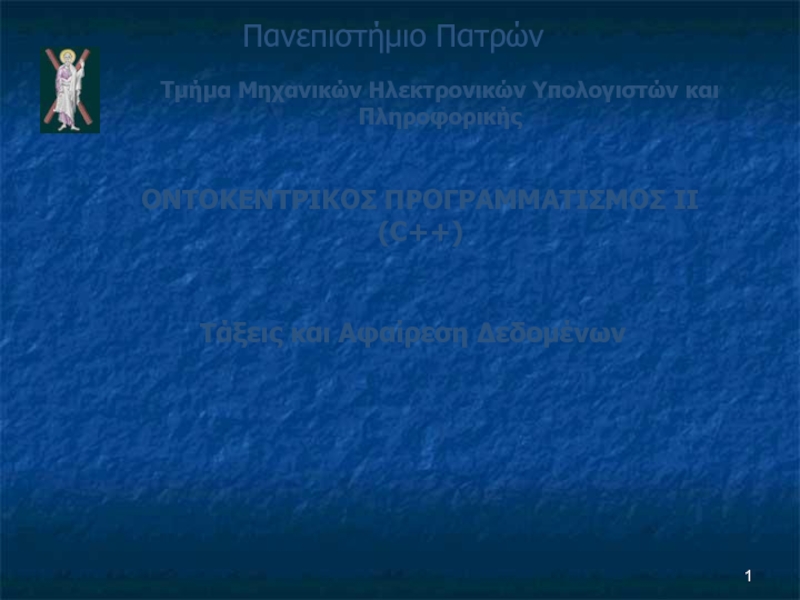
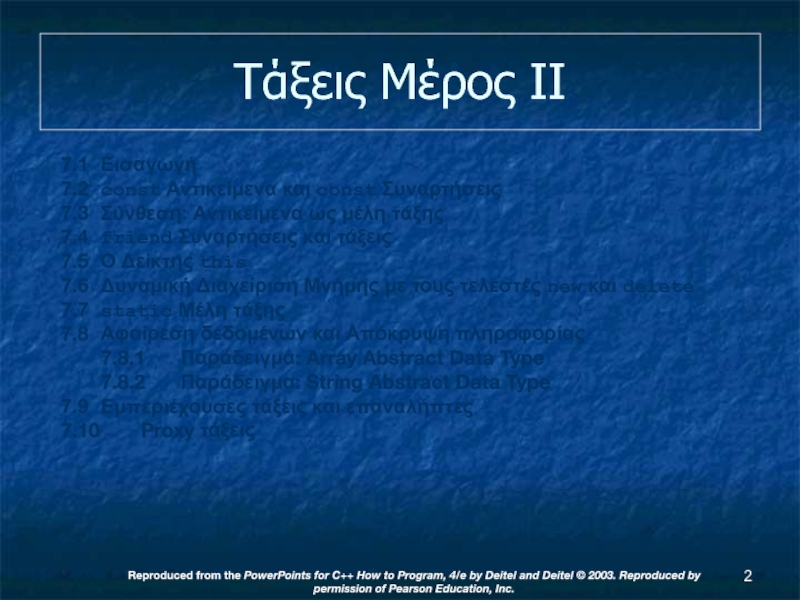
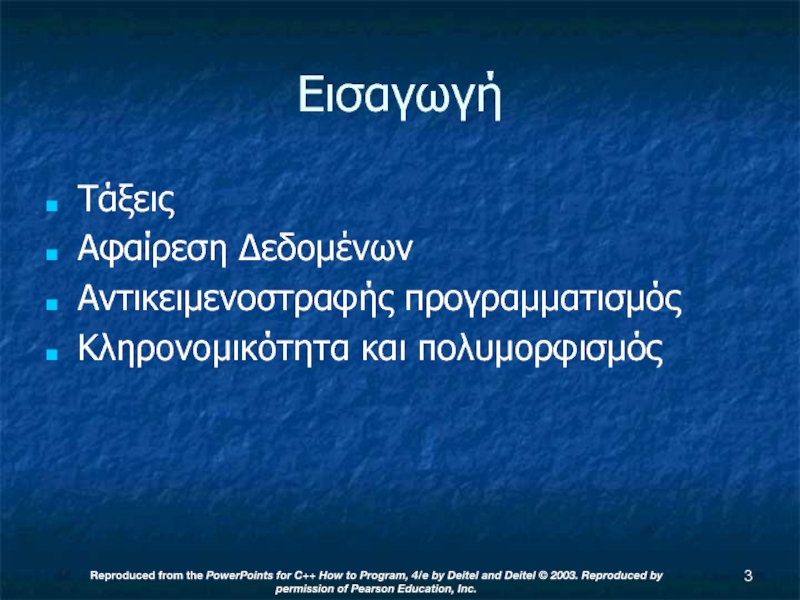
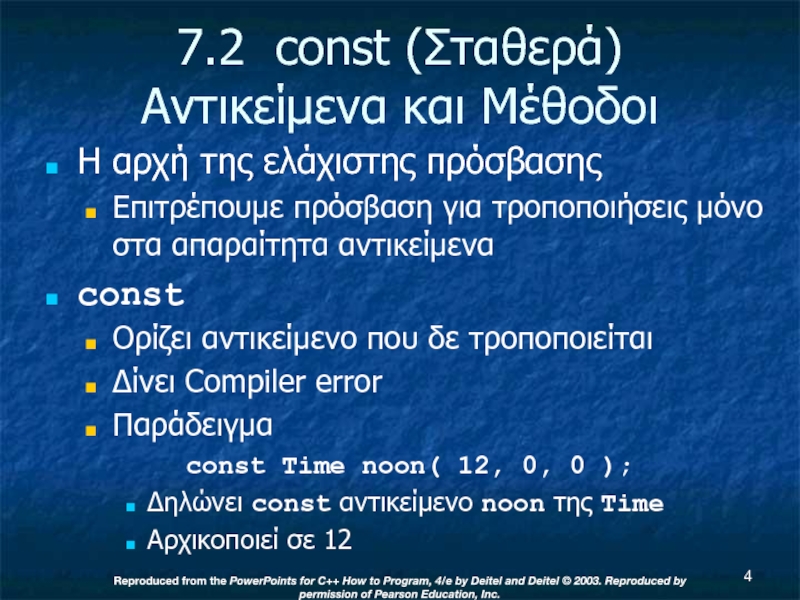
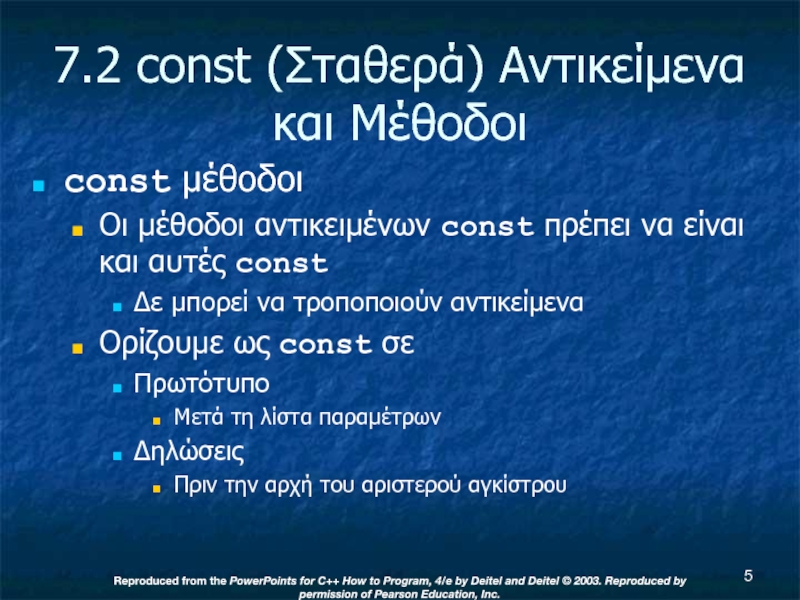
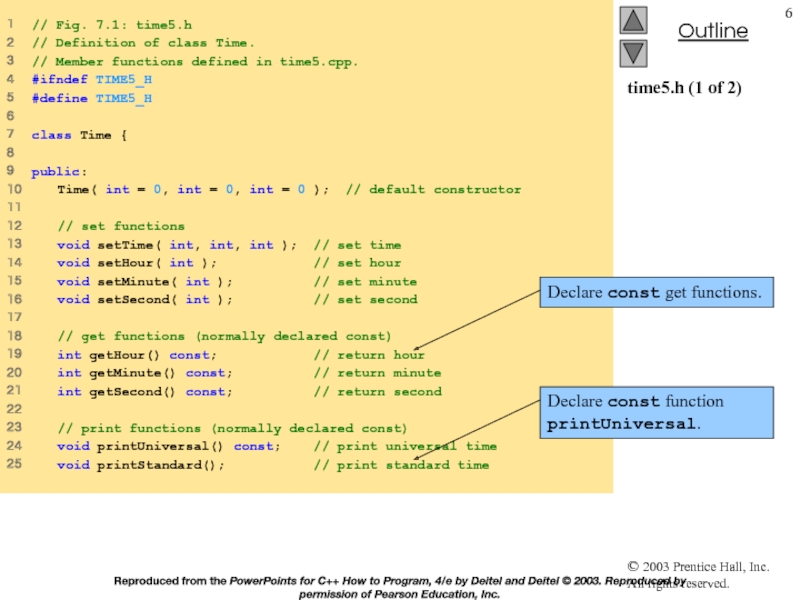
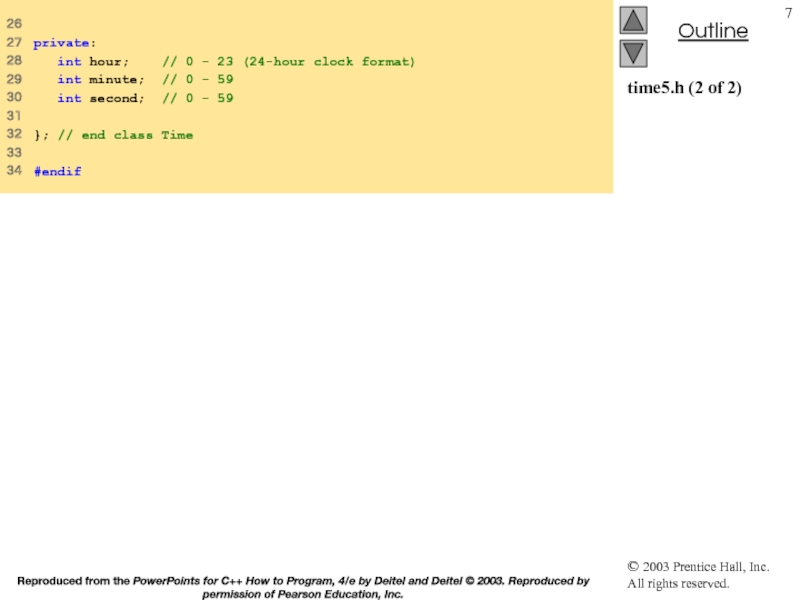
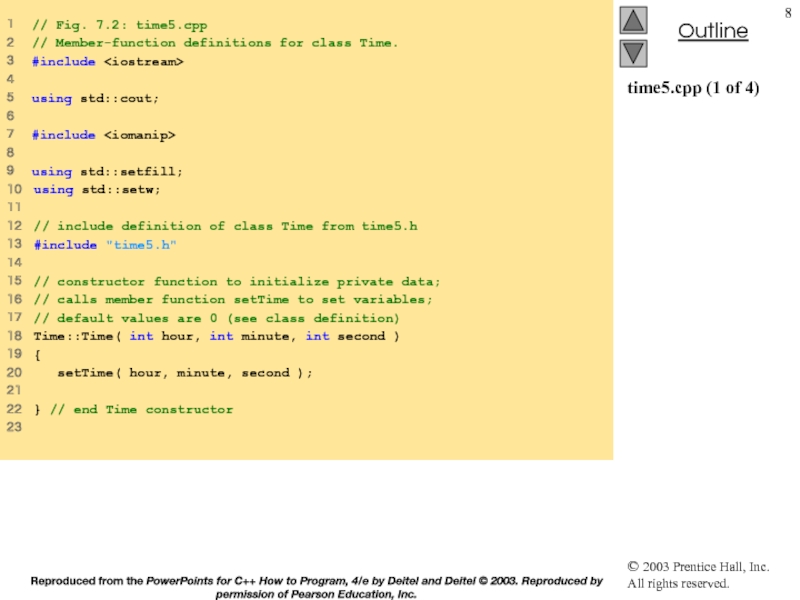
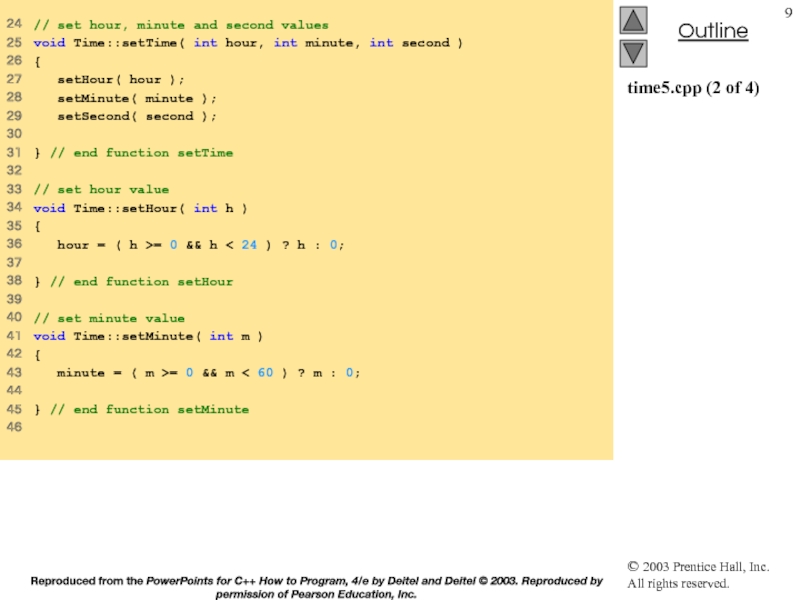
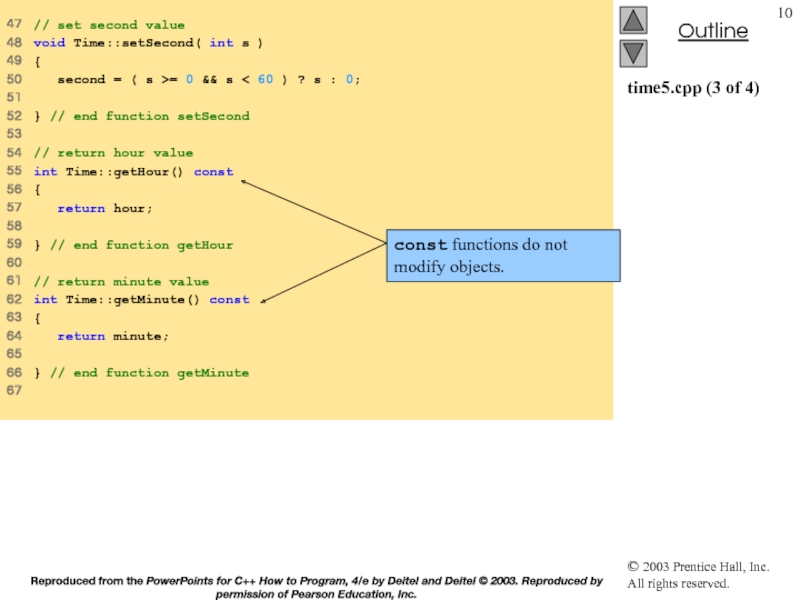
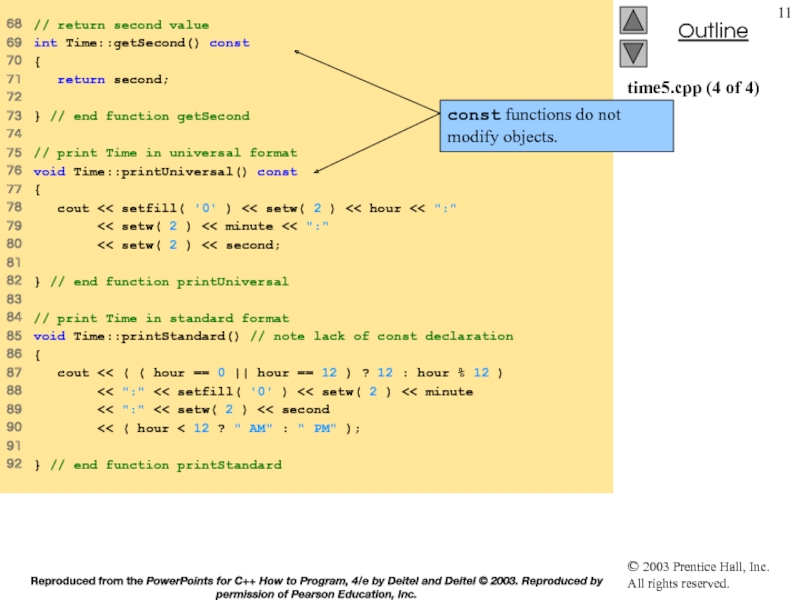
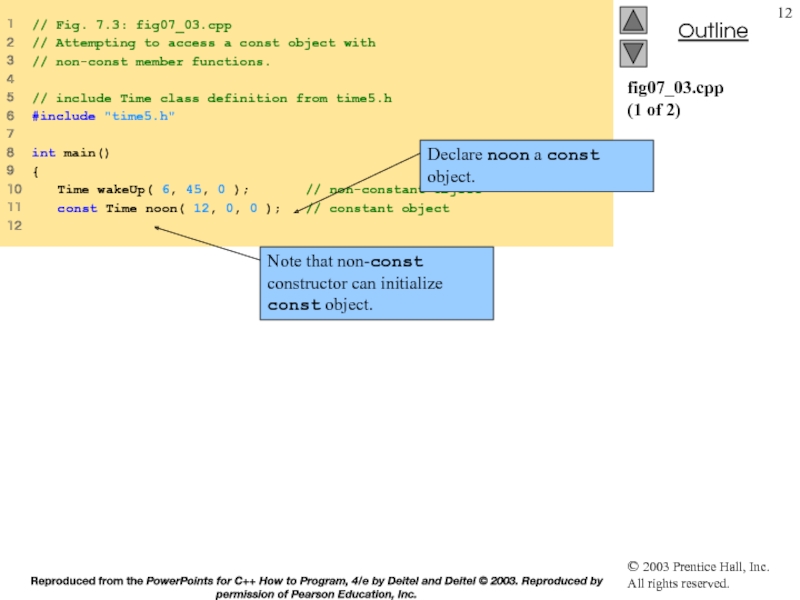
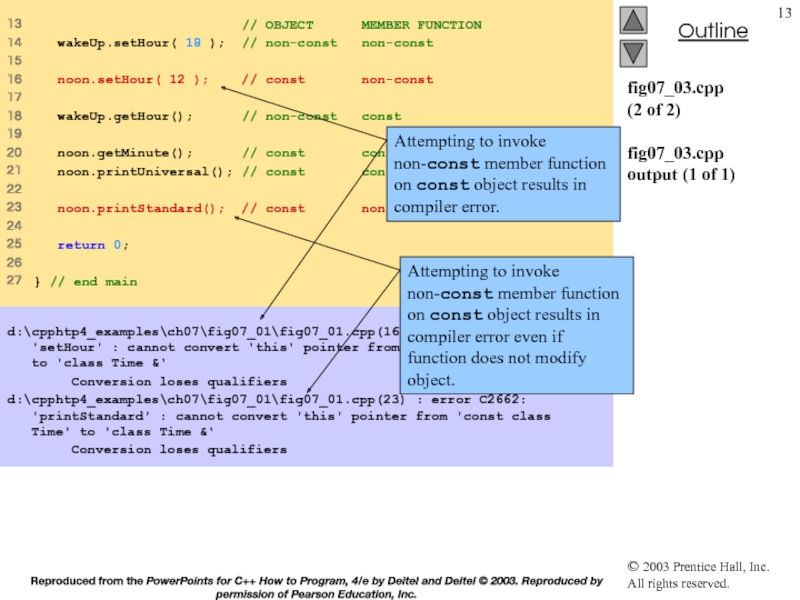
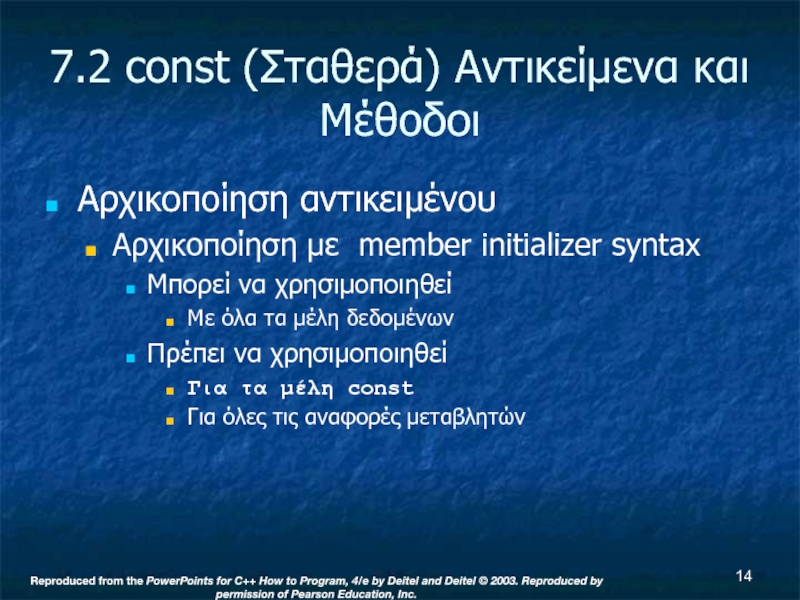
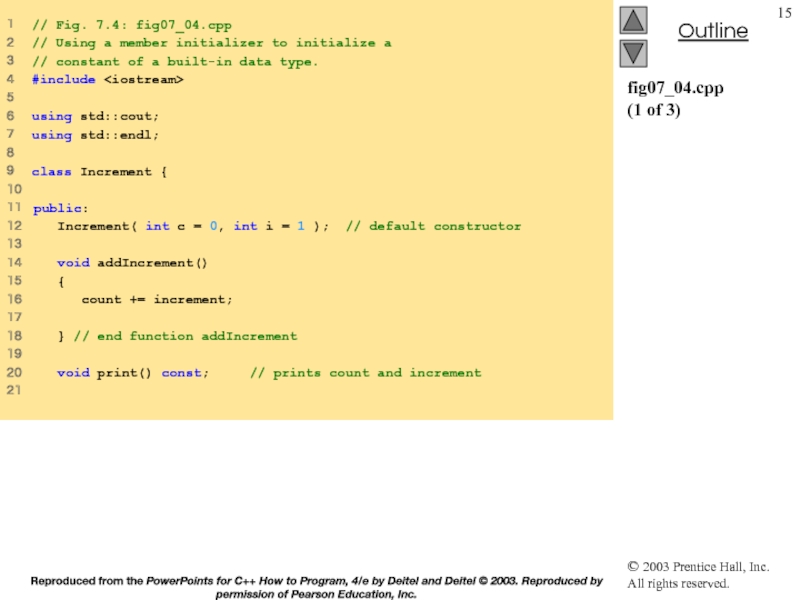
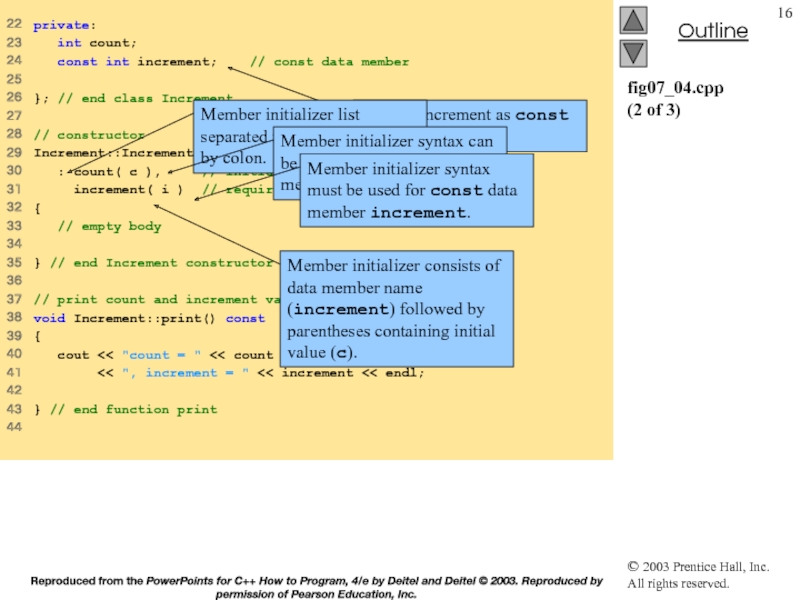
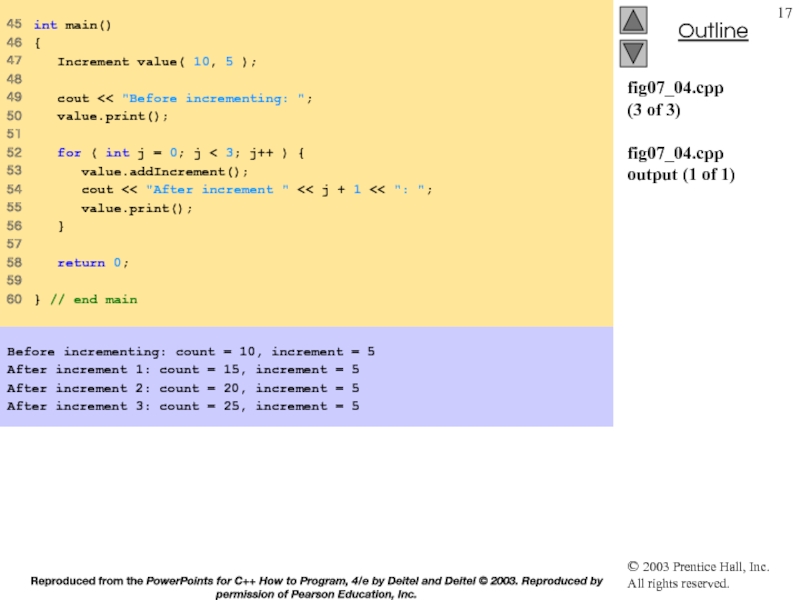
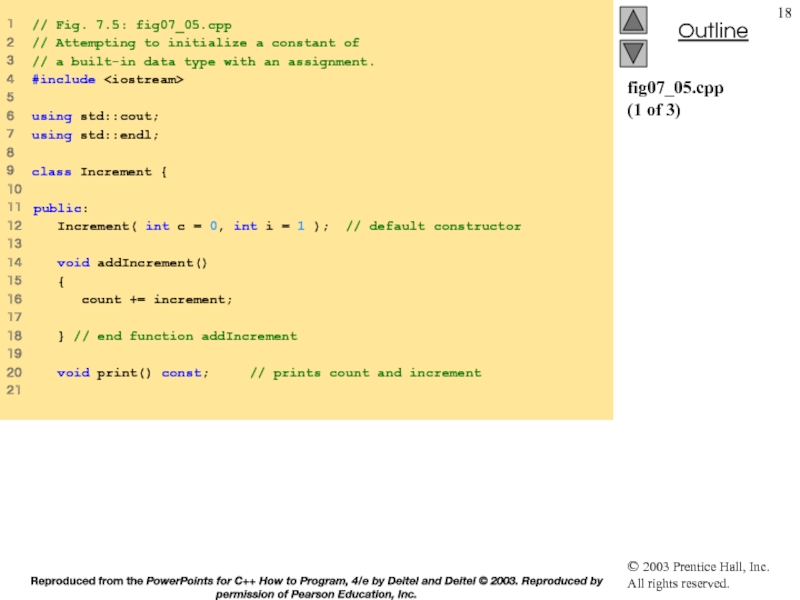
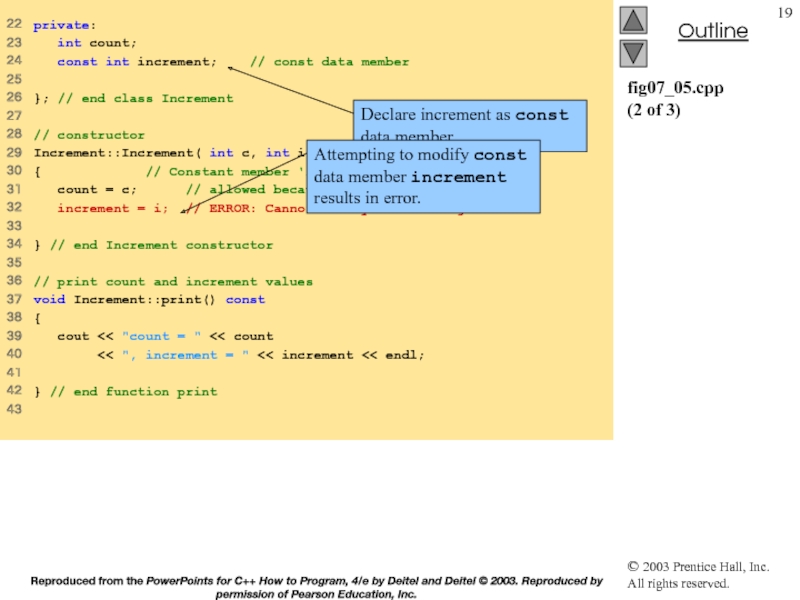
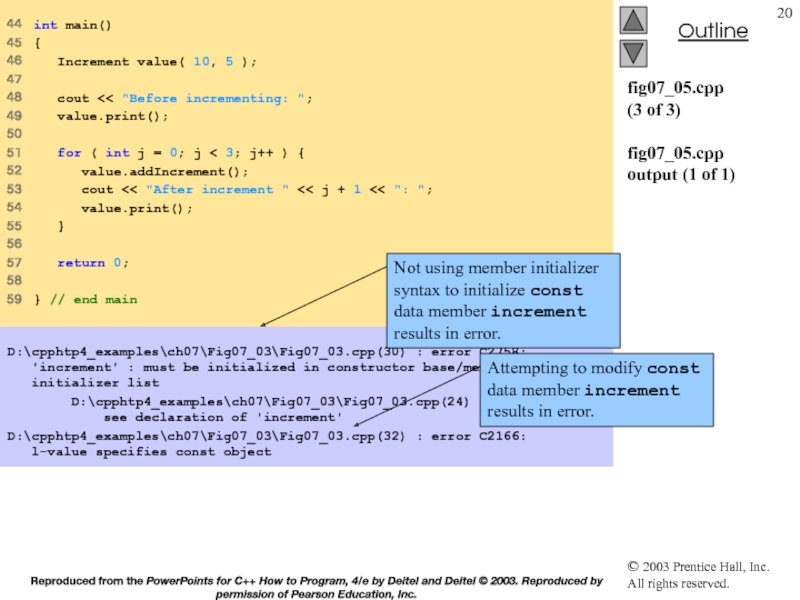
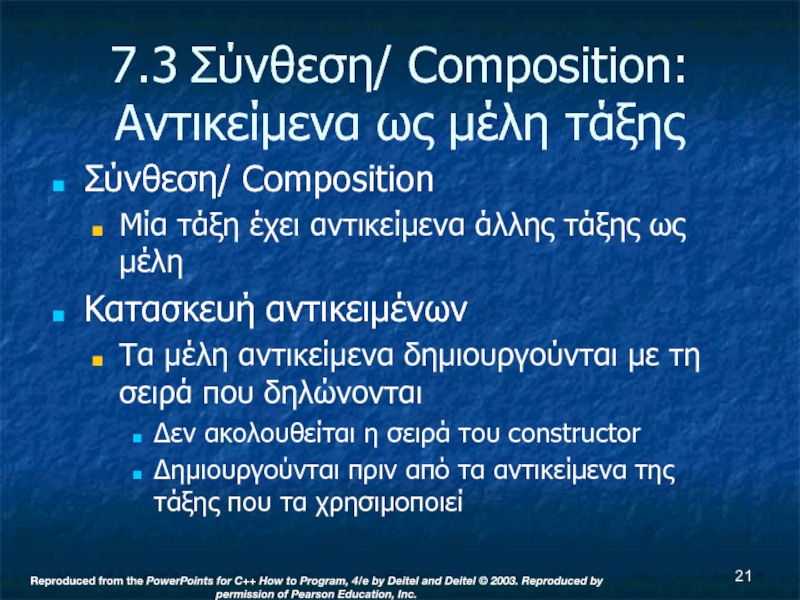
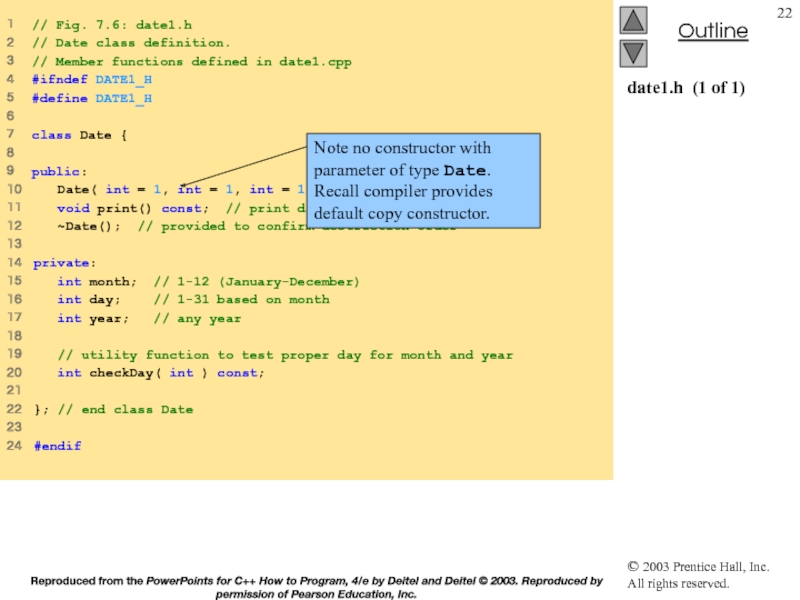
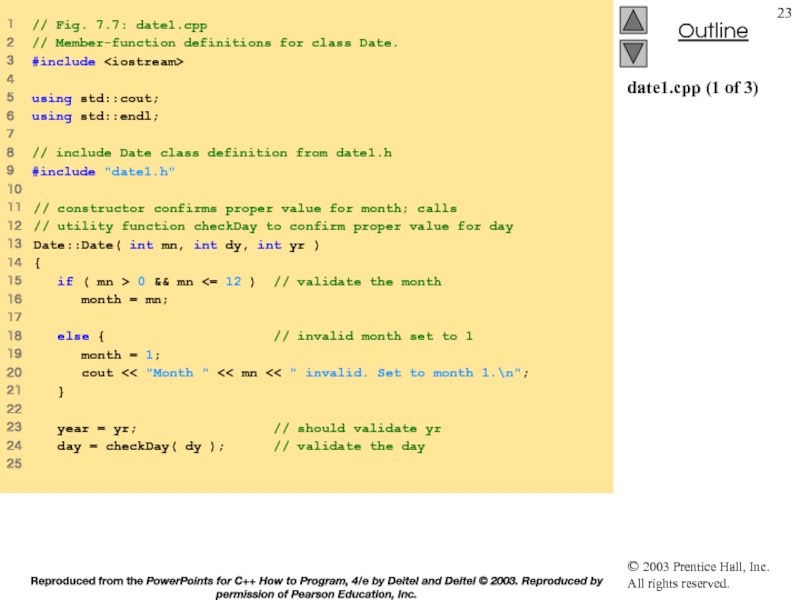
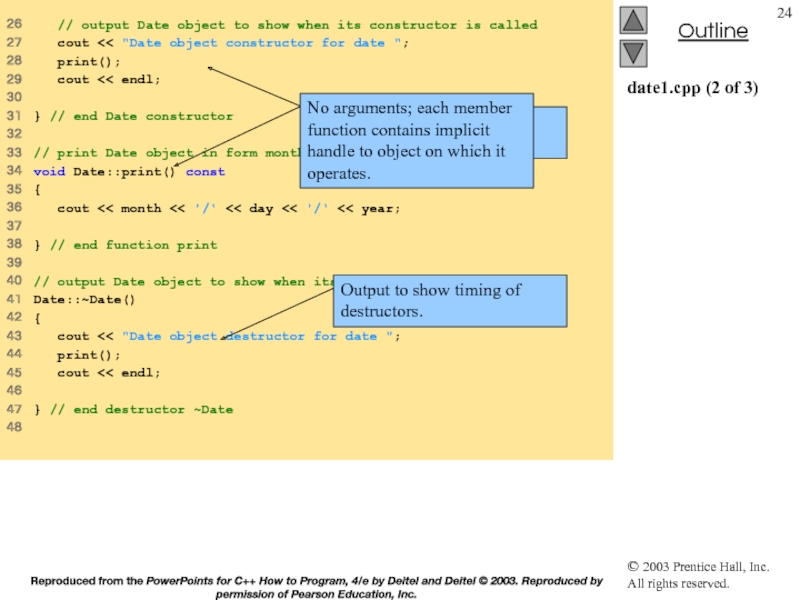
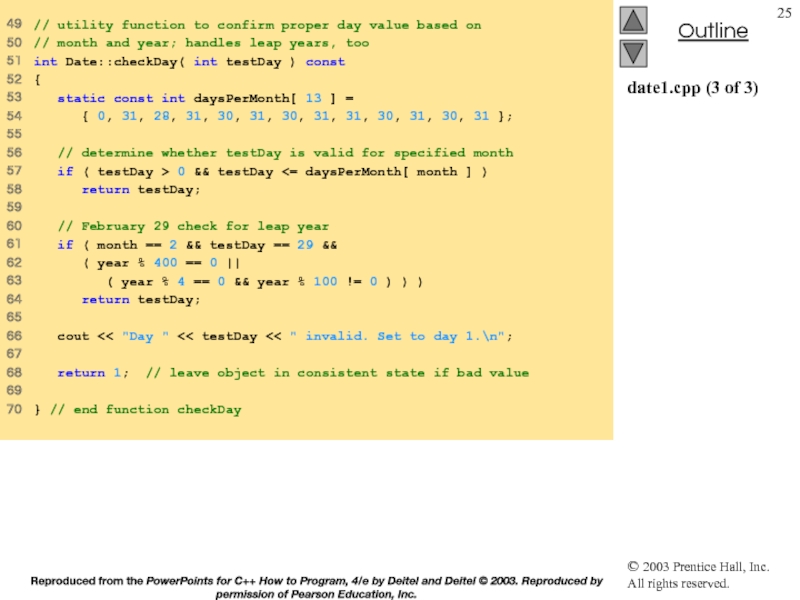
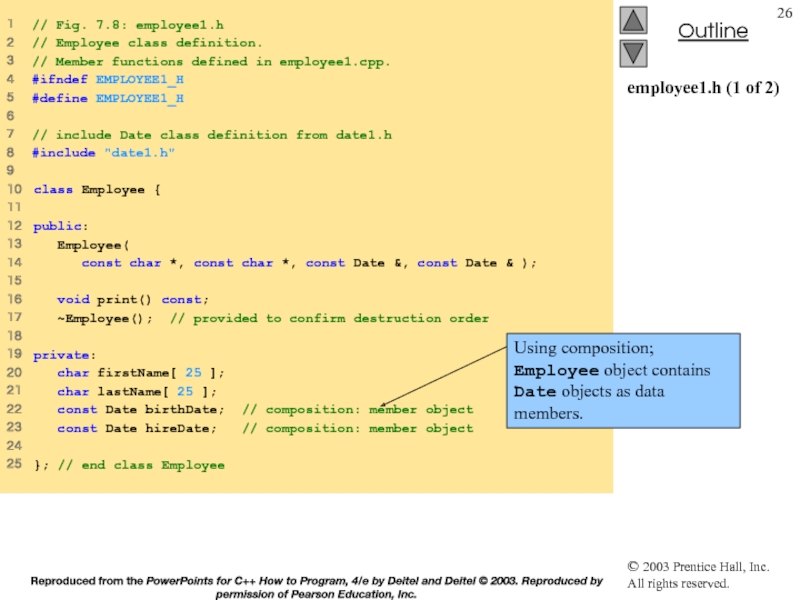
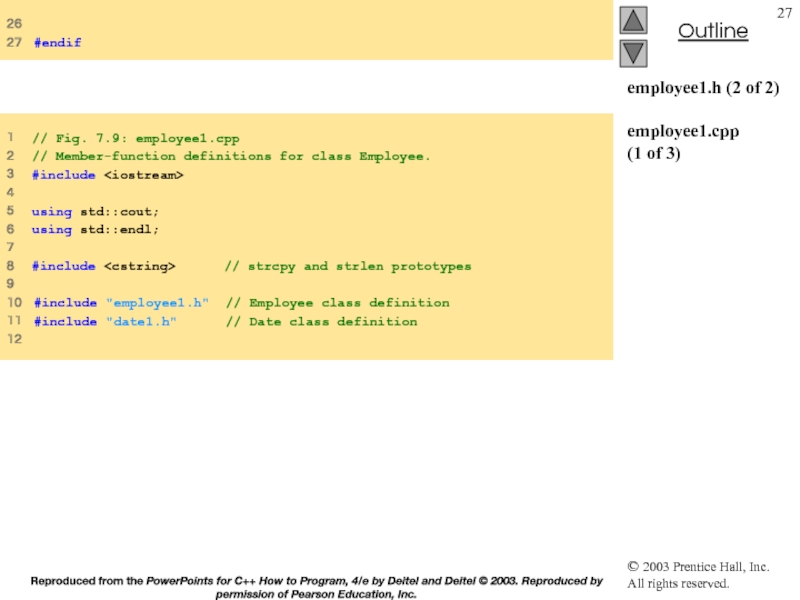
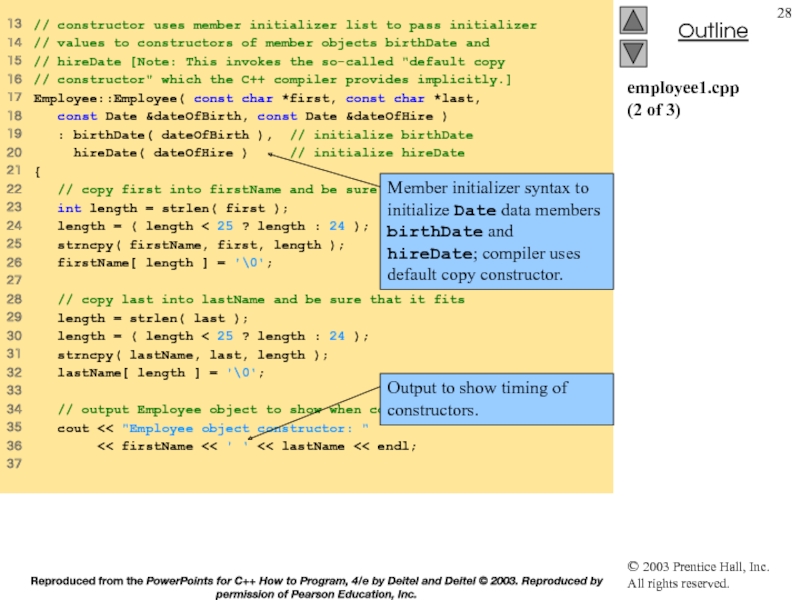
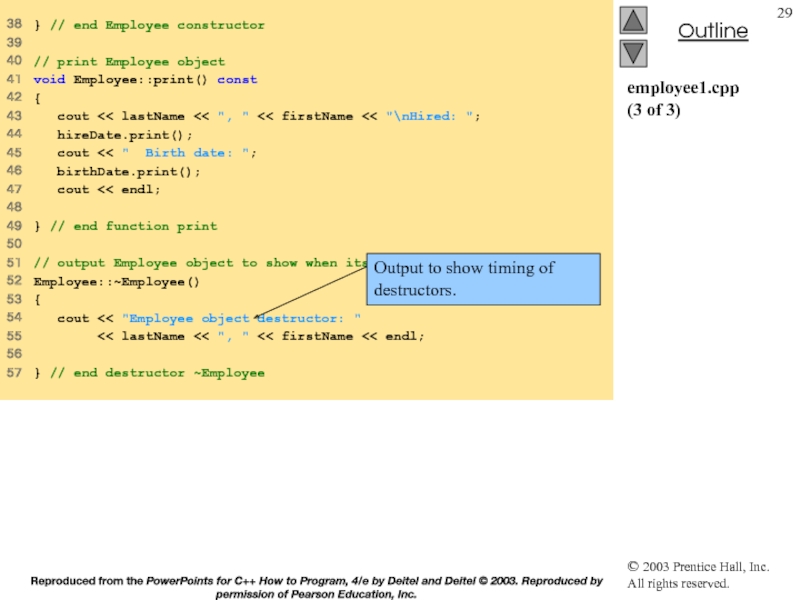
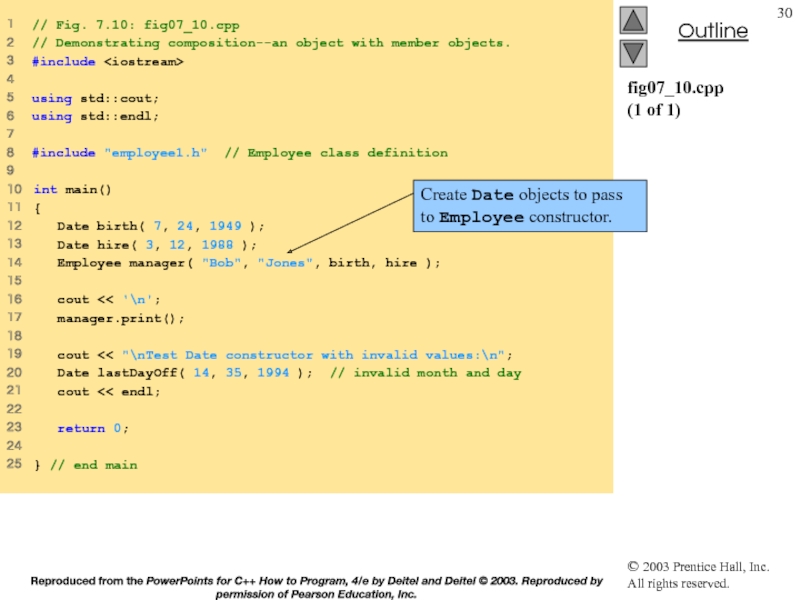
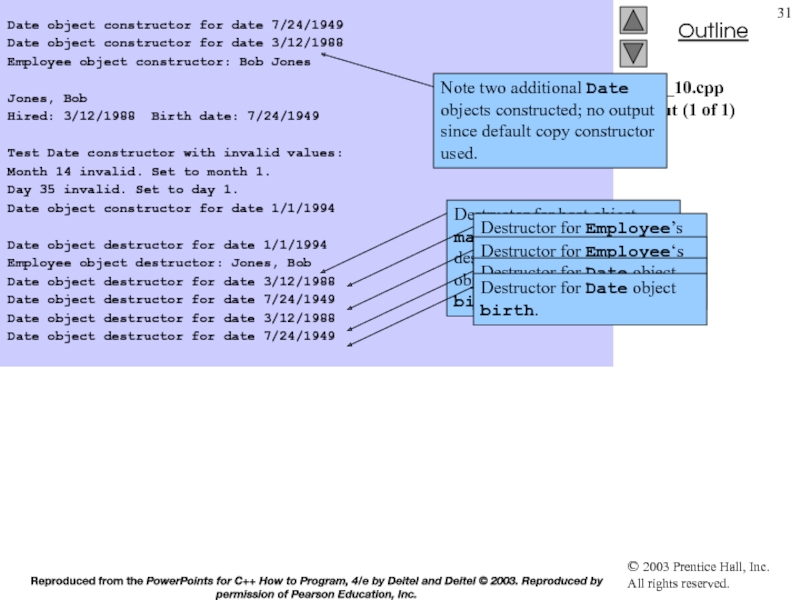
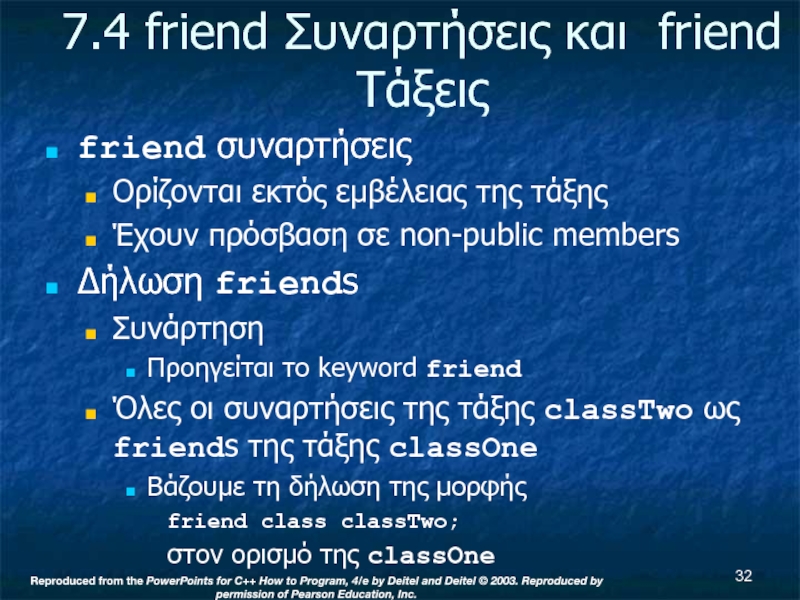
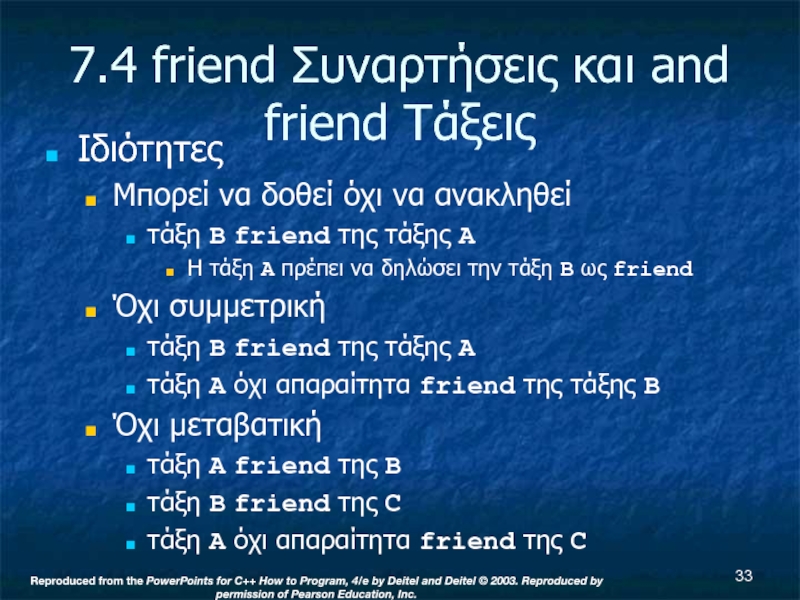
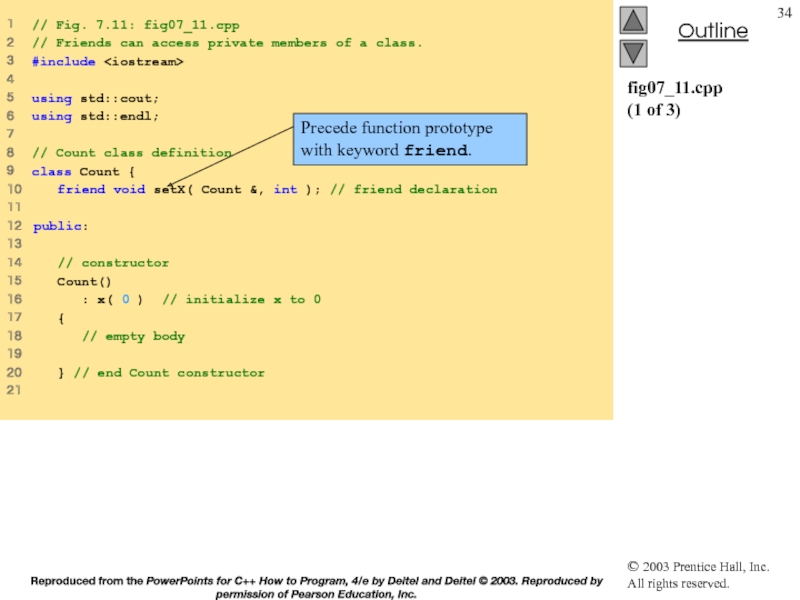
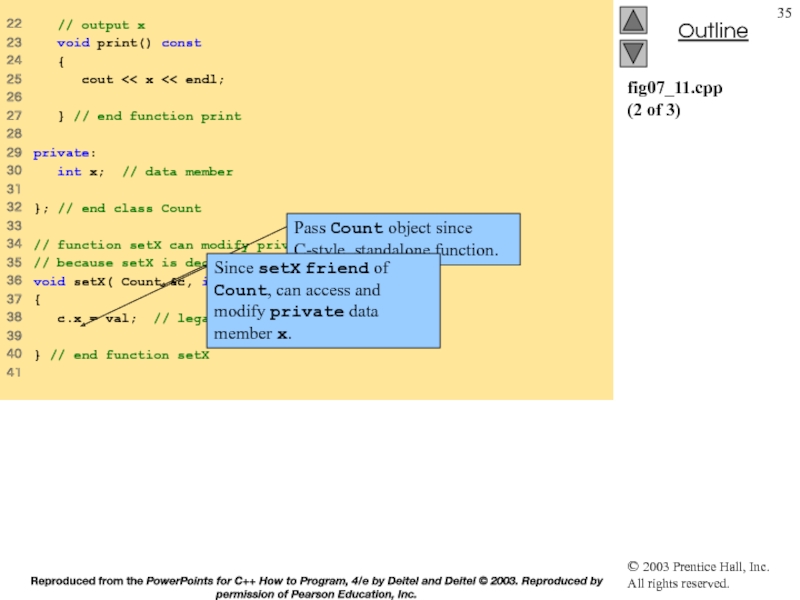
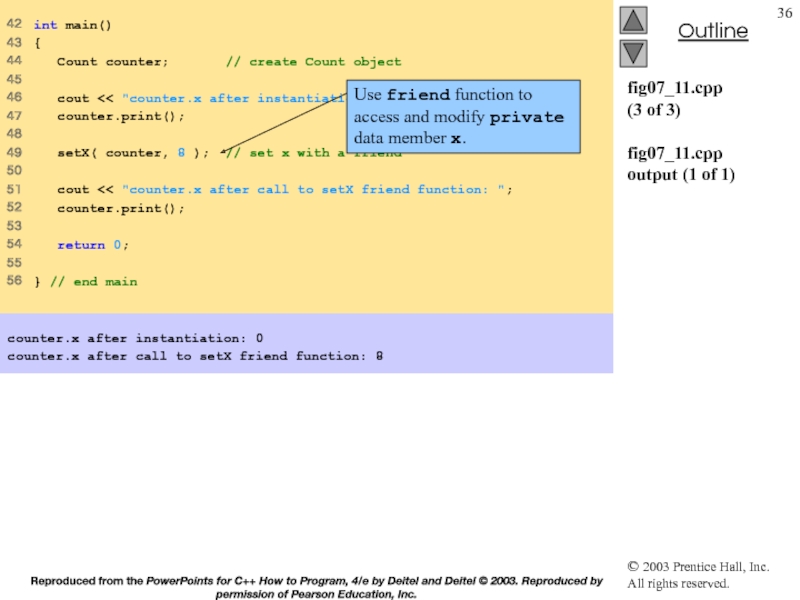
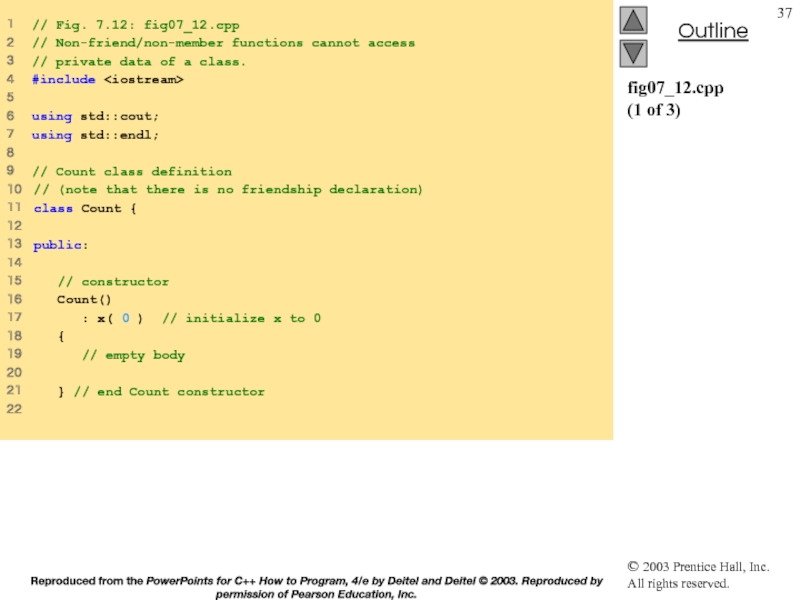
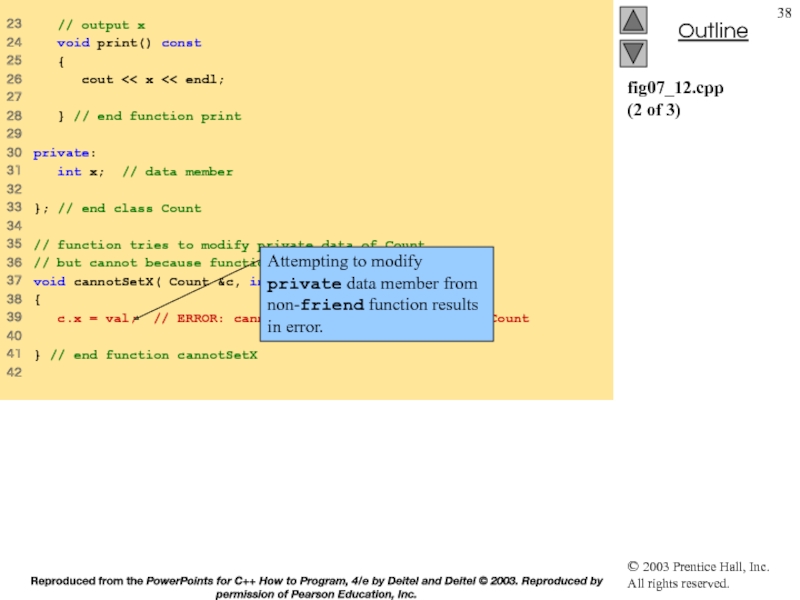
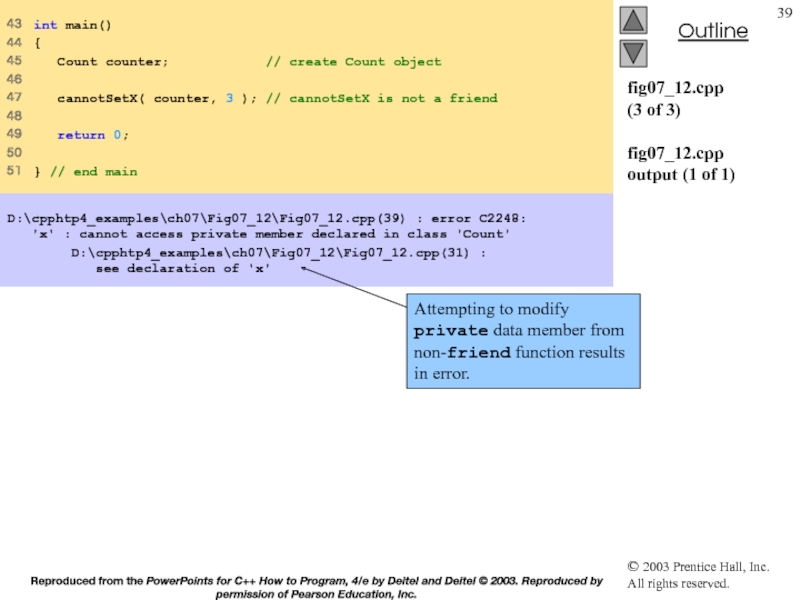
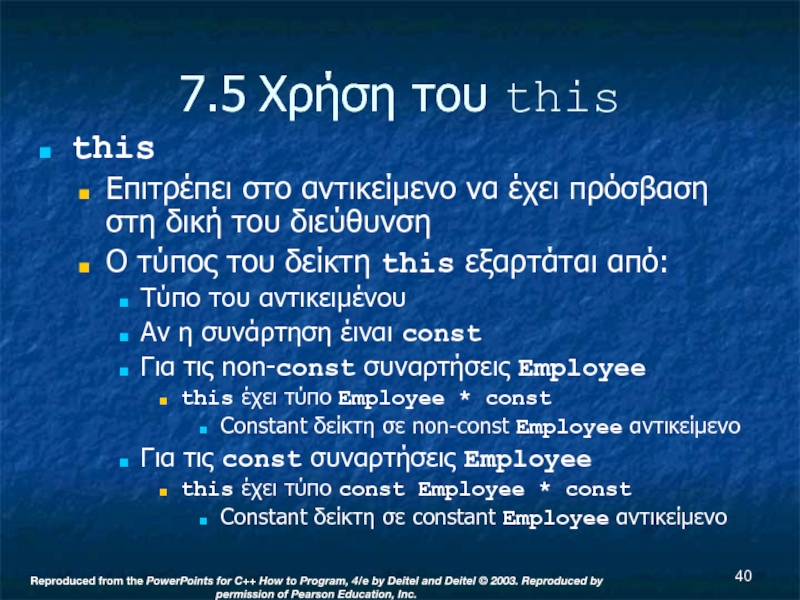
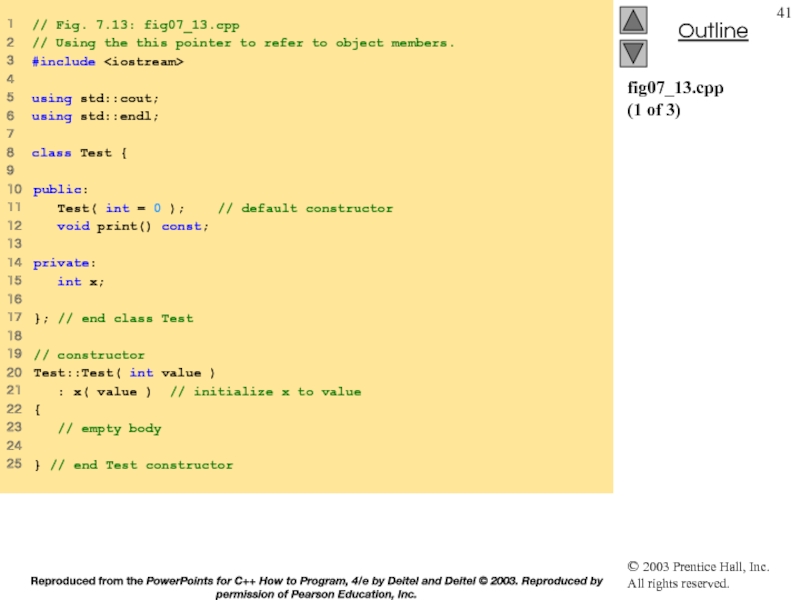
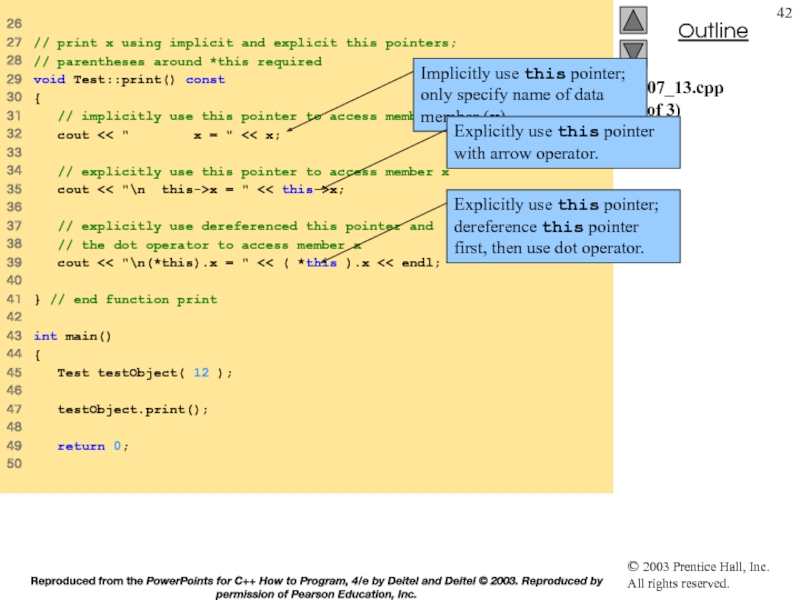
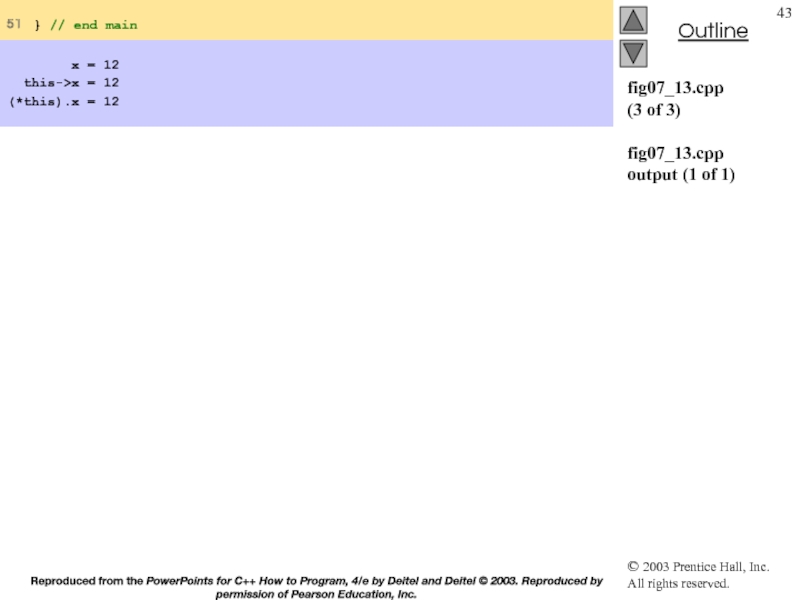
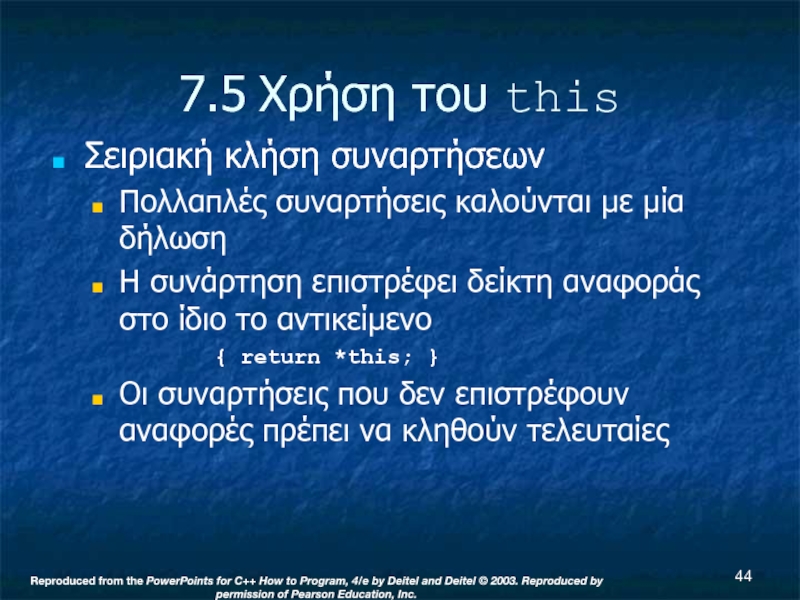
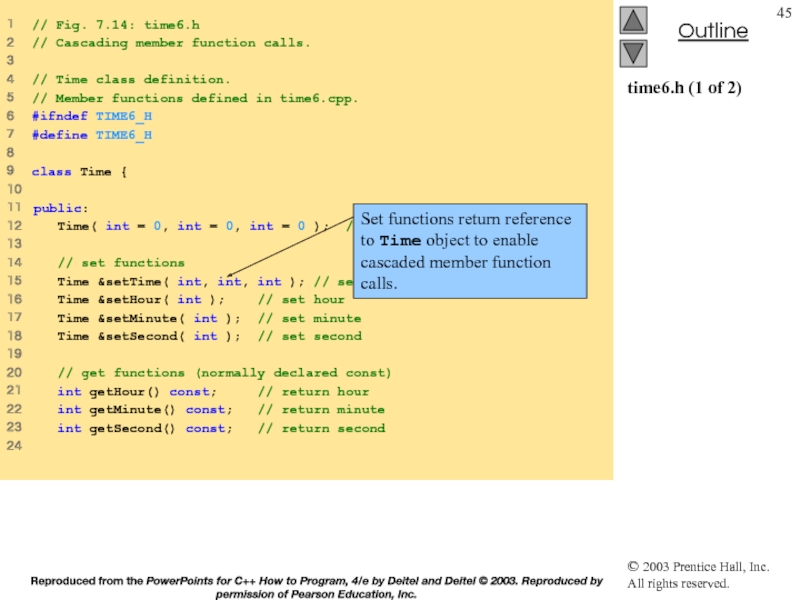
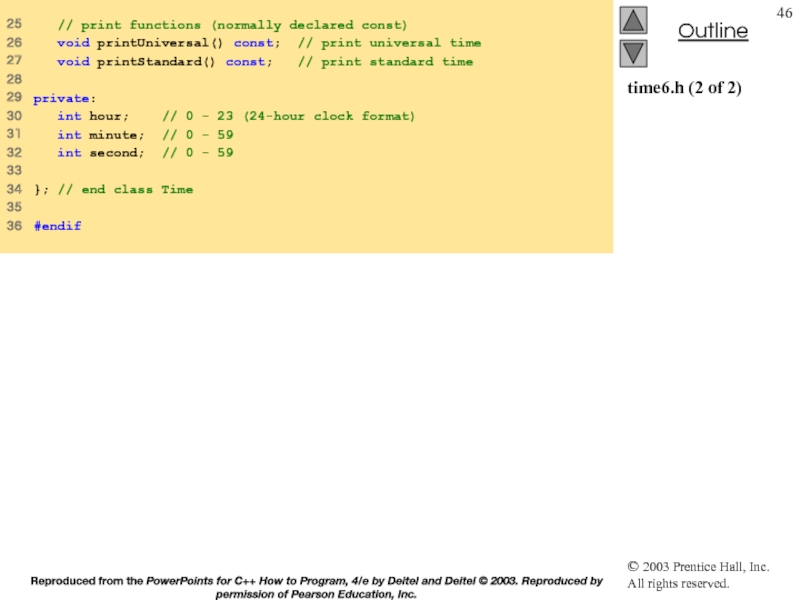
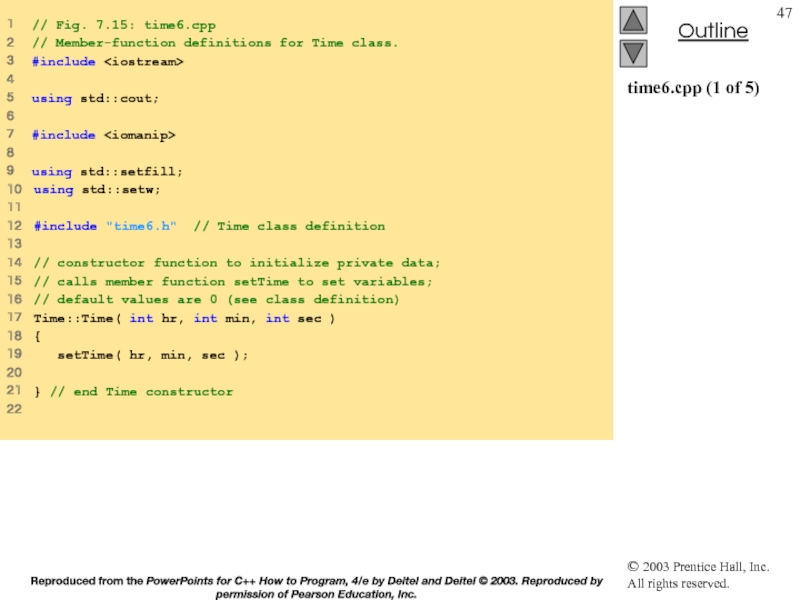
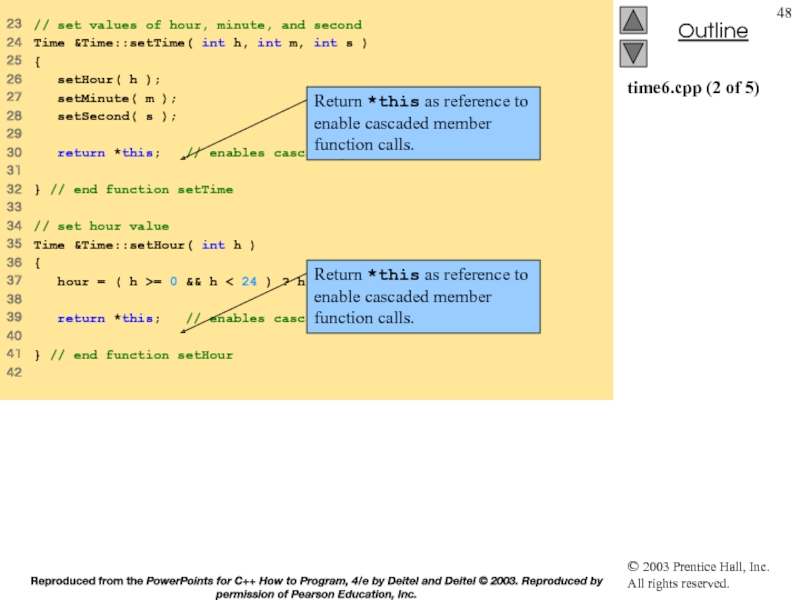
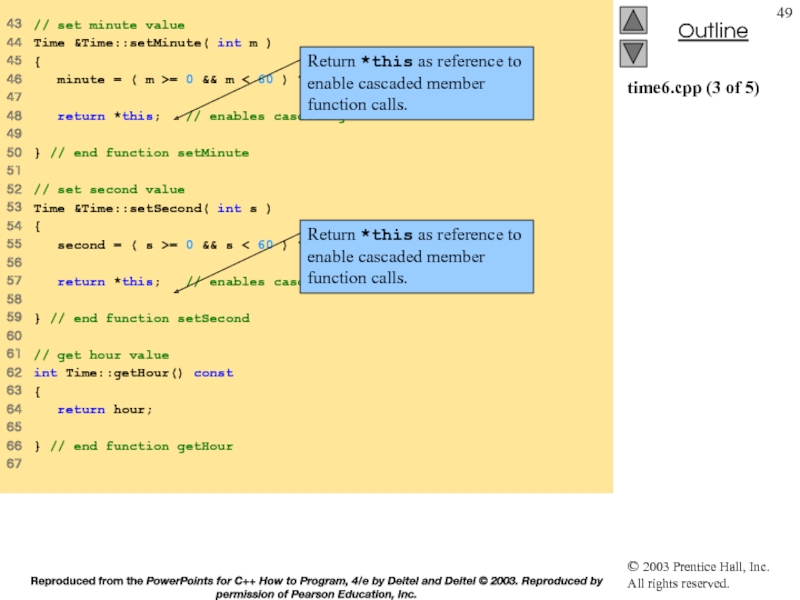
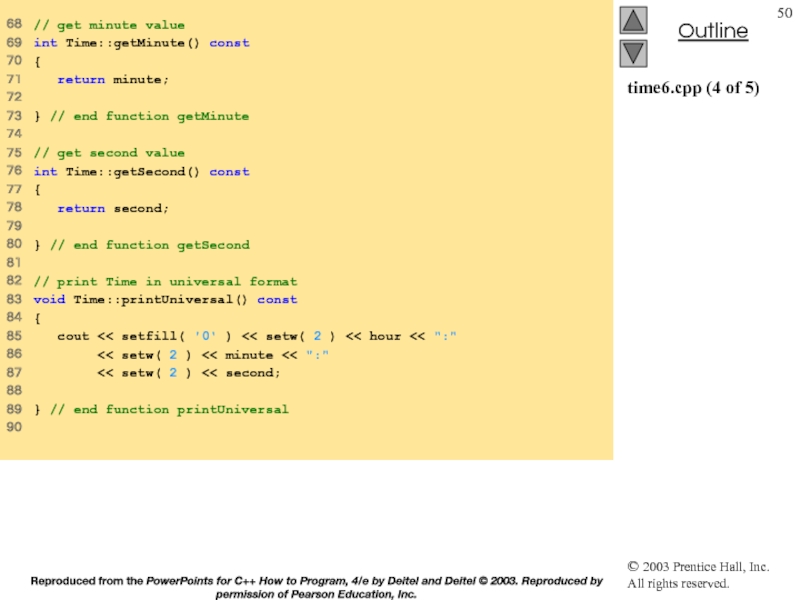
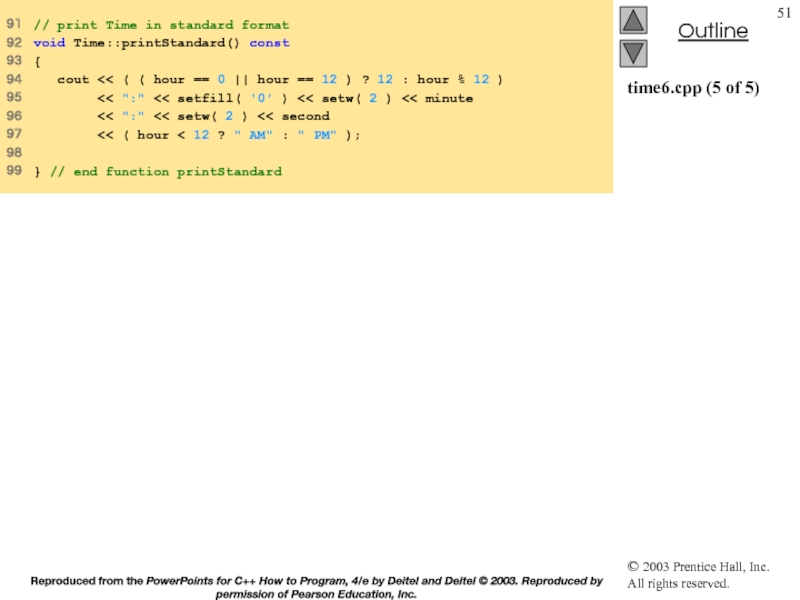
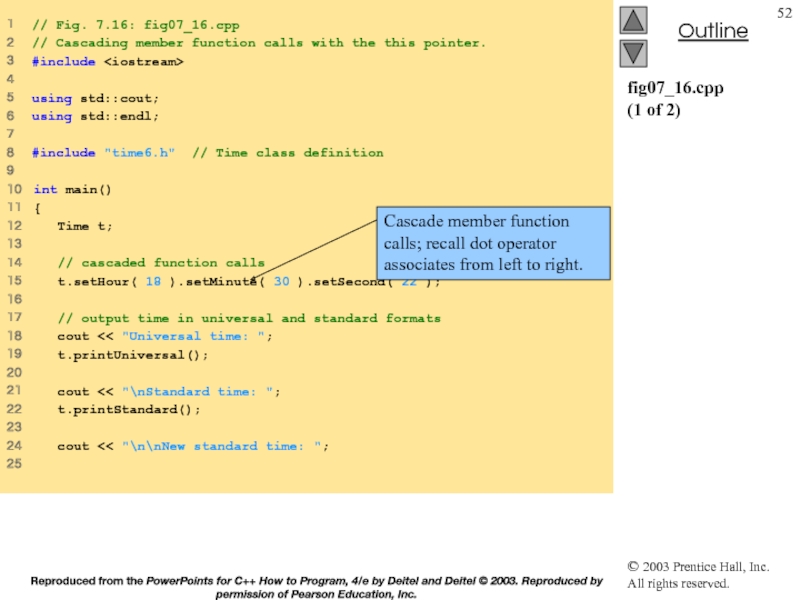
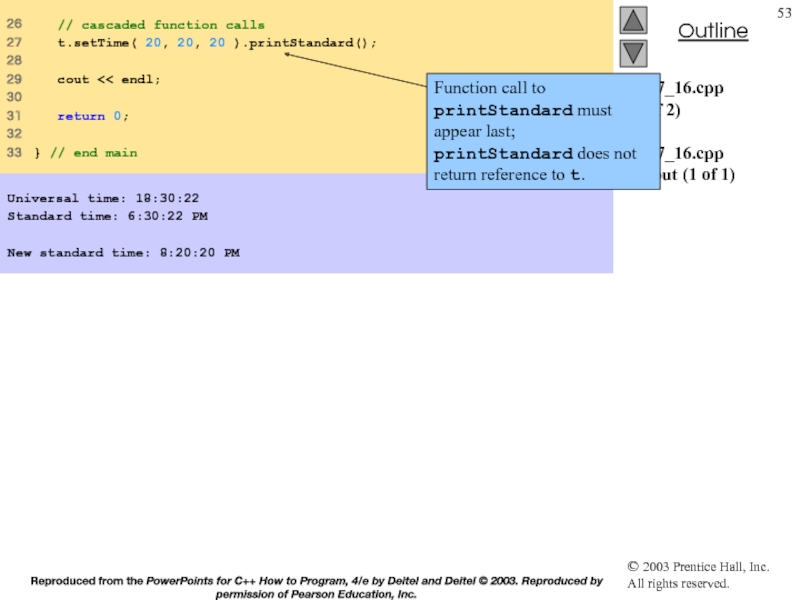
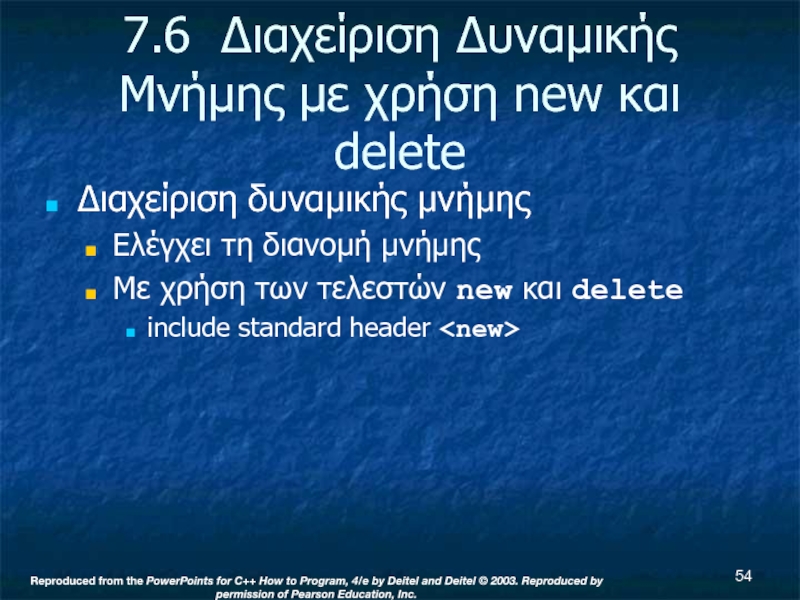
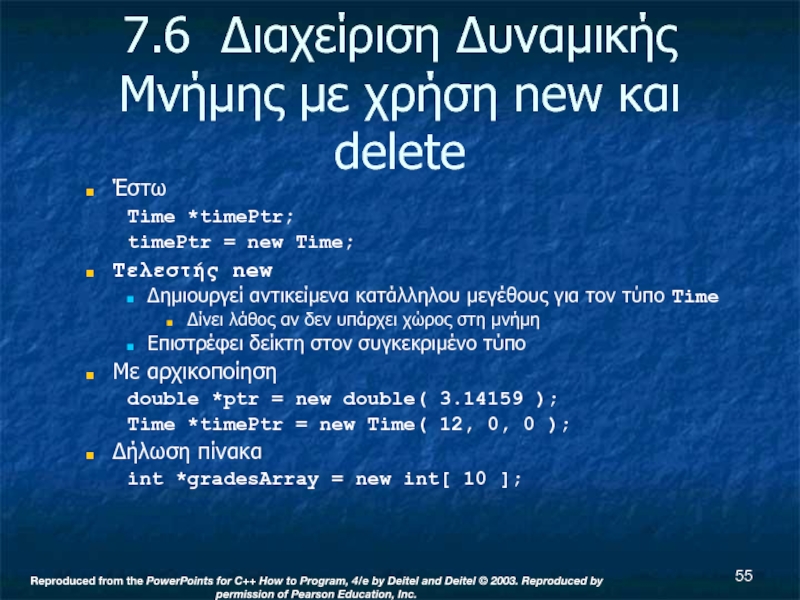
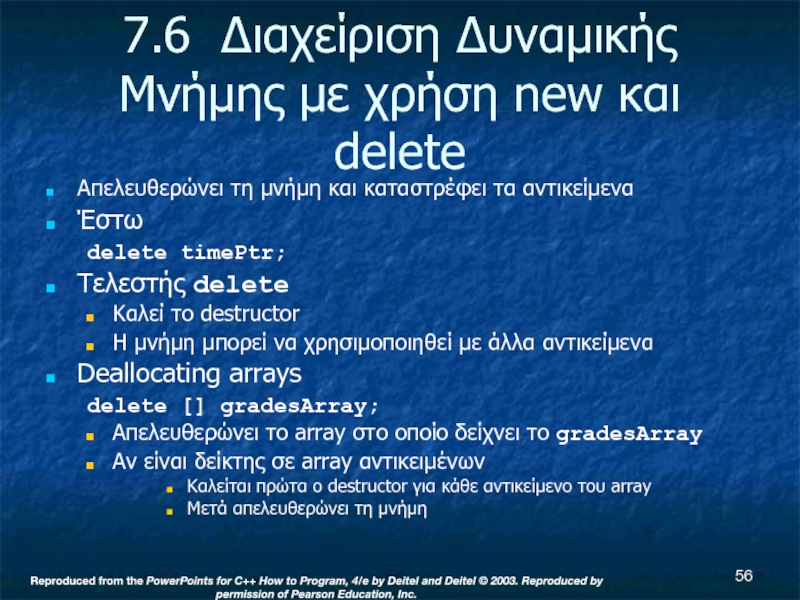
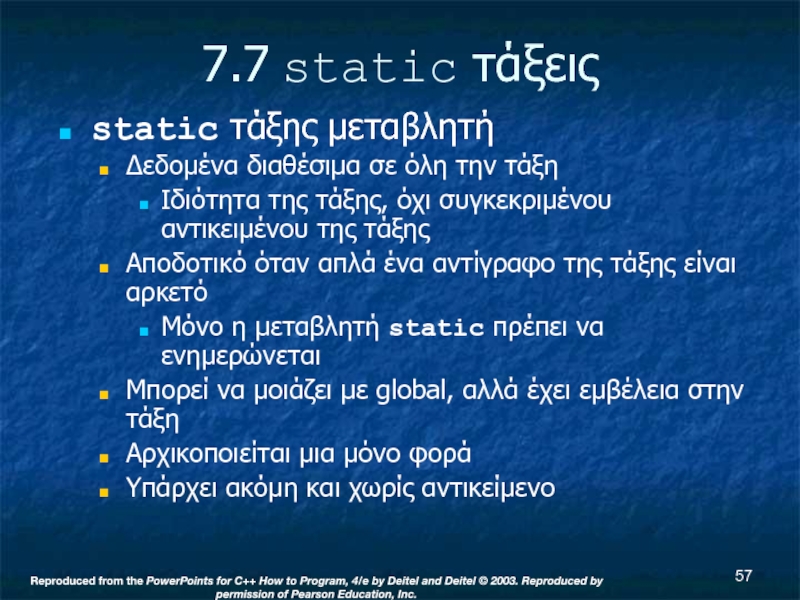
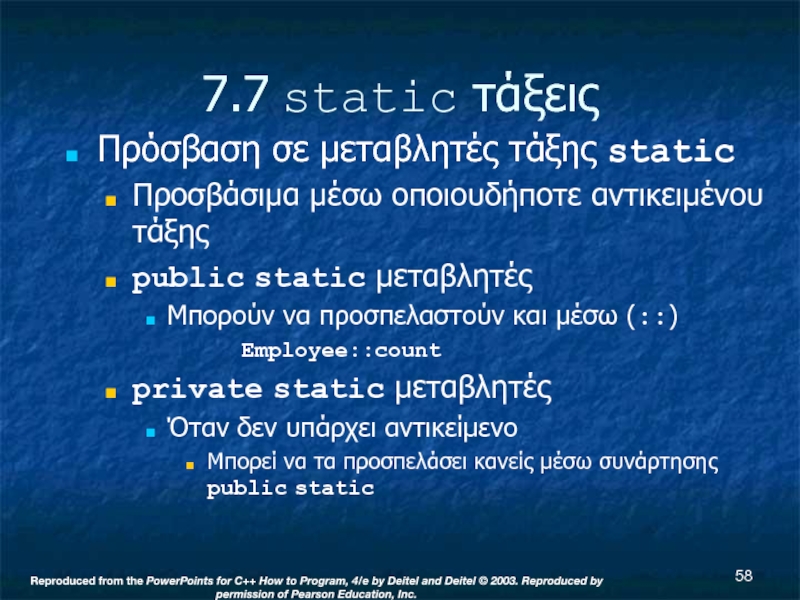
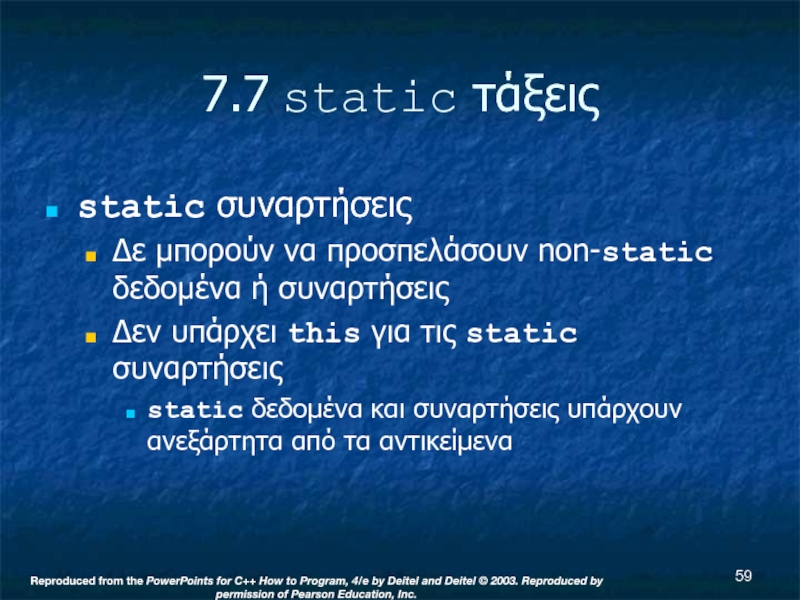
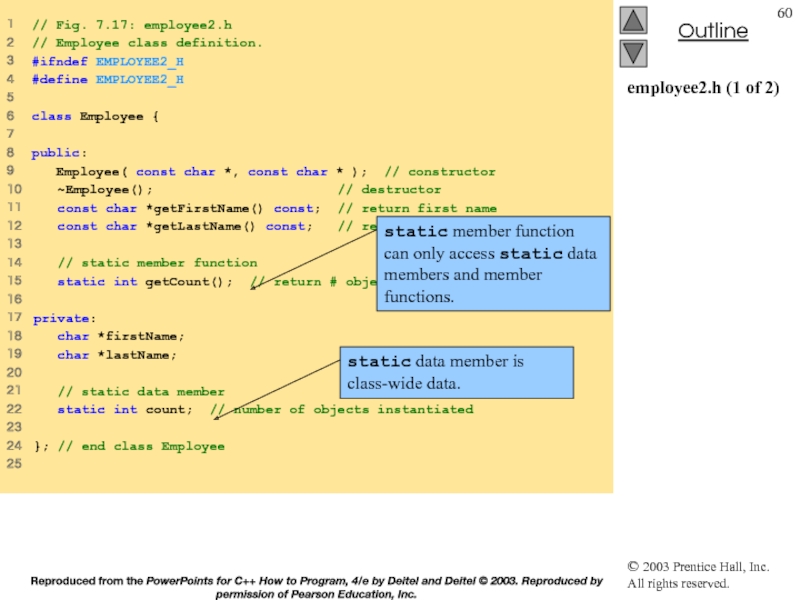
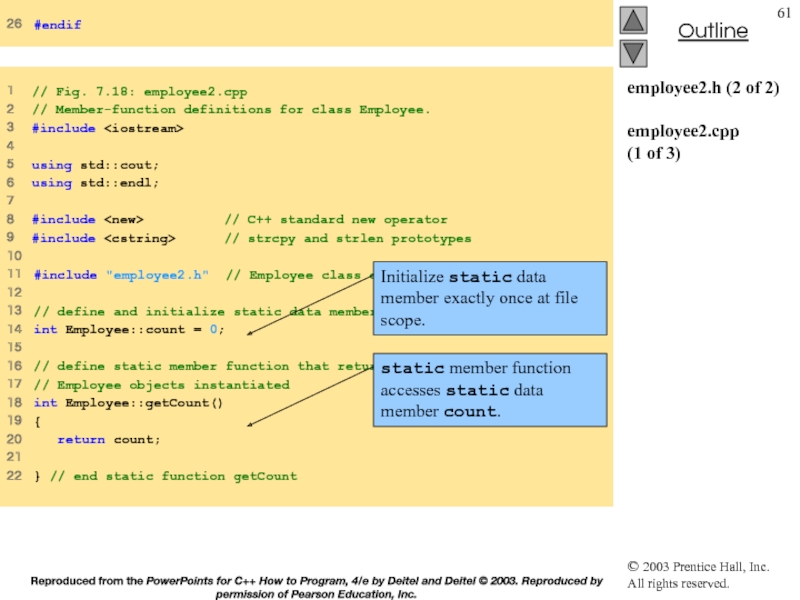
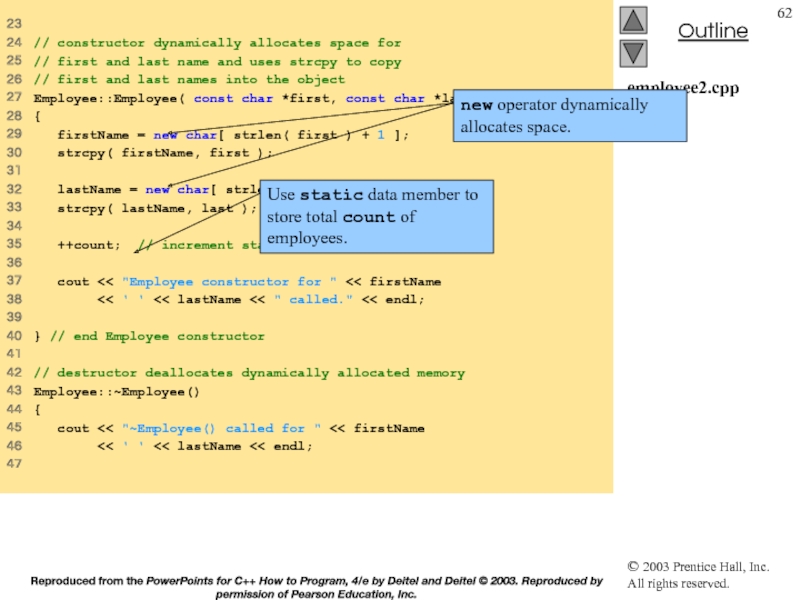
![employee2.cpp (3 of 3) 48 delete [] firstName; // recapture memory49 delete []](/img/tmb/4/377946/8fe64010207e5d50102fde1f499b8d7a-800x.jpg)
